Will Pfeifer's Blog, page 16
March 22, 2016
You Need to Read This Big Fat Punk Art Book
Following up on the post devoted to "Enjoy the Experience," a book that celebrated offbeat musicians you've never, ever heard of, here's another big fat hardcover devoted to offbeat musicians that you just might have heard of.
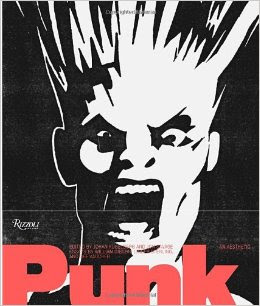
Like the title suggests, "Punk: An Aesthetic" is devoted to the artwork, the advertising, the design, the decor and the overall look that epitomized punk rock, ranging from the pre-punk scene of the early 1970s (and even earlier) to the post-post-post punk decades of the 21st century, when Jamie Reid's once combustible ransom-note Sex Pistols logo can be found on, of all things, a baby's onesie. Talk about cash from chaos.
Still, that's sort of the point of the whole book. Ever since the beginning -- since way before the beginning, in fact, punk was a commodity, a look or attitude being used to sell something. Usually records or concert tickets, of course, but even before then it was being used to sell trashy magazines (there's a spread from a 1956 issue of a Canton, Ohio, mag called The Tabloid that hypes "PUNK STREET IN NEW YORK CITY that I'd love to get my hands on), sleazy paperbacks (a 1957 cash-in titled "The Young Punks") and incomprehensible art movements (our old friends the Situationists get plenty of space here).
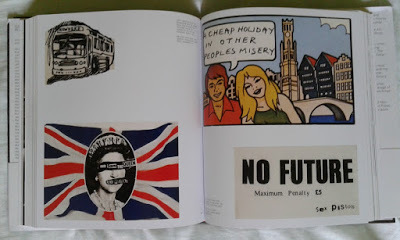
What's great about "Punk: An Aesthetic" (and, let me be clear, this is a pretty damn great book) is that in its effort to cover the entire spectrum of punk-related art and culture, it includes some wonderfully odd and obscure artifacts. Sure, the classics are all here, from the aforementioned Mr. Reid's postcards, record covers and safety-pinned queens to the stark black-and-white photos of NYC pioneers like The Ramones, Television and punk's pin-up princess herself, Debbie Harry. But you also get pages from forgotten regional zines, covers of sleazy punksploitation mags and, in one of my favorite spreads, the complete original art from the 1978 spoof, "Mad's Punk Rock Group of the Year." It's a great strip, full of confusion from the older generation and gritty, grimy Harry North art that somehow -- accidentally, no doubt -- captures the gritty, grimy magic of the era.
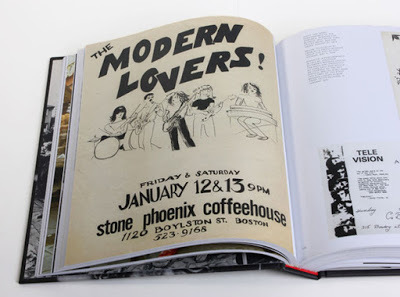
Your love of "Punk: An Aesthetic" will, of course, depend on your love of punk itself -- not to mention your love of crude design, snotty humor and irrational bursts of anger and violence. Naturally, I love all of that stuff, so I'm a sucker for this book. There's smart, sophisticated commentary on the whole era by guys like Jon Savage and William Gibson, but for me, the pictures are why this one is worth picking up. Whether it's the British tabloids wailing and gnashing their teeth over the Sex Pistols' foul-mouthed TV appearance or a piece of Publishers Clearing House junk mail sent to none other than Mr. Kurt Cobain, this is some choice stuff. Grab your copy, put on a record (might I suggest The Ramones' "Leave Home"?) and relive those grand, glorious, gob-encrusted days of yesterday. Gabba gabba hey indeed.

Like the title suggests, "Punk: An Aesthetic" is devoted to the artwork, the advertising, the design, the decor and the overall look that epitomized punk rock, ranging from the pre-punk scene of the early 1970s (and even earlier) to the post-post-post punk decades of the 21st century, when Jamie Reid's once combustible ransom-note Sex Pistols logo can be found on, of all things, a baby's onesie. Talk about cash from chaos.
Still, that's sort of the point of the whole book. Ever since the beginning -- since way before the beginning, in fact, punk was a commodity, a look or attitude being used to sell something. Usually records or concert tickets, of course, but even before then it was being used to sell trashy magazines (there's a spread from a 1956 issue of a Canton, Ohio, mag called The Tabloid that hypes "PUNK STREET IN NEW YORK CITY that I'd love to get my hands on), sleazy paperbacks (a 1957 cash-in titled "The Young Punks") and incomprehensible art movements (our old friends the Situationists get plenty of space here).

What's great about "Punk: An Aesthetic" (and, let me be clear, this is a pretty damn great book) is that in its effort to cover the entire spectrum of punk-related art and culture, it includes some wonderfully odd and obscure artifacts. Sure, the classics are all here, from the aforementioned Mr. Reid's postcards, record covers and safety-pinned queens to the stark black-and-white photos of NYC pioneers like The Ramones, Television and punk's pin-up princess herself, Debbie Harry. But you also get pages from forgotten regional zines, covers of sleazy punksploitation mags and, in one of my favorite spreads, the complete original art from the 1978 spoof, "Mad's Punk Rock Group of the Year." It's a great strip, full of confusion from the older generation and gritty, grimy Harry North art that somehow -- accidentally, no doubt -- captures the gritty, grimy magic of the era.

Your love of "Punk: An Aesthetic" will, of course, depend on your love of punk itself -- not to mention your love of crude design, snotty humor and irrational bursts of anger and violence. Naturally, I love all of that stuff, so I'm a sucker for this book. There's smart, sophisticated commentary on the whole era by guys like Jon Savage and William Gibson, but for me, the pictures are why this one is worth picking up. Whether it's the British tabloids wailing and gnashing their teeth over the Sex Pistols' foul-mouthed TV appearance or a piece of Publishers Clearing House junk mail sent to none other than Mr. Kurt Cobain, this is some choice stuff. Grab your copy, put on a record (might I suggest The Ramones' "Leave Home"?) and relive those grand, glorious, gob-encrusted days of yesterday. Gabba gabba hey indeed.
Published on March 22, 2016 18:23
March 7, 2016
Movies I Watched in February
I slacked it a bit this month, with a mere four movies making the list. (Sue me -- X-Files, Downton Abbey, Vinyl, Brooklyn 99, John Oliver and a lot of other, non-cinematic entertainment -- not to mention my actual life -- filled my schedule.) But they were definitely four very different, fairly interesting movies. Let's run them down, shall we?I've been a fan of the National Lampoon since I first paged through an issue during a seventh grade study hall, and I've been an avid fan since college when I came pretty close to assembling a complete collection. The magazine's combination of razor-sharp satire and a breathtakingly brutal sense of humor still has the power to impress (and offend) today, more than 40 years after the Lampoon first hit the stands. This documentary is a pretty solid look at the rise and fall of the Lampoon, fueled by interviews with just about every surviving member of the staff (even co-founder Henry Beard, who went decades without talking about his time at the magazine). There are plenty of samples of the articles, too, though like most documentaries about the printed word, the filmmakers resort to all sorts of half-assed animation to keep things interesting. Still, it's a good way to pass a couple of hours, it will show you just how not-groundbreaking "Saturday Night Live" was, and some of the articles -- for example, the Vietnamese Baby Book -- will still cause you to gasp all these years later. There are a lot of books telling the history of the National Lampoon from various angles, and if nothing else, this fun movie should inspire you to pick one of them up.
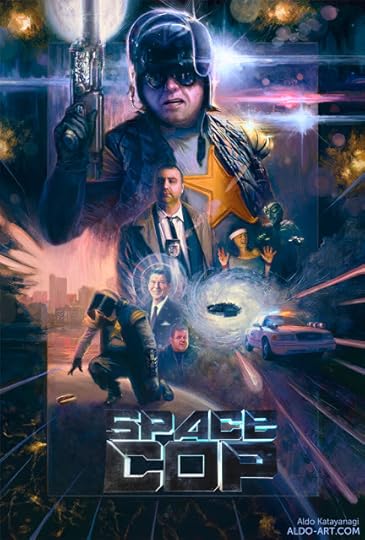
Maybe you've heard of Red Letter Media, the Wisconsin company led by Mike Stoklasa and Jay Bauman. They're the guys who produced all those hilarious -- and surprisingly accurate -- videos dissecting every single way that the "Star Wars" prequels fail as movies, as entertainment and as a continuation of Lucas' legacy. Stoklasa narrated those as the gravelly voiced "Mr. Plinkett," but in this sci-fi satire he and Bauman step back and let Rich Evans take center stage as "Space Cop," an incompetent, lazy, slow-witted law officer of the future. When he arrives in the present day, he's teamed up with a cryogenically frozen cop from the past (Stoklasa) and together, they have to battle an alien invasion (which includes Bauman, somehow). "Space Cop" is a crude, dopey comedy, but it's also very funny, and it's smart in the way it plays with the cliches of the genre. All three actors have fun with their roles, and you can bet your life it's better than whatever Adam Sandler or Kevin James epic is lurking down at your local multiplex. Want to watch it? Order it here.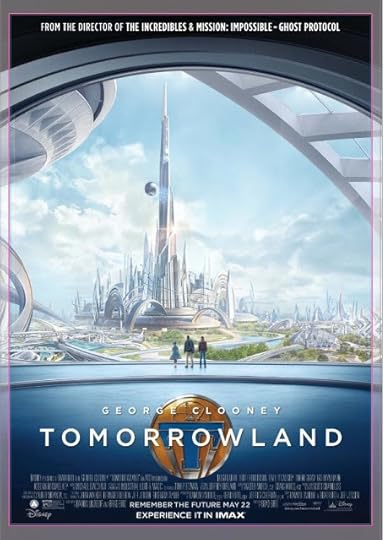
I had high hopes for this one, I really did. I'm fascinated by the whole concept of the futuristic outlook of the World's Fair, which this movie draws from. I've never seen a movie by director Brad Bird that I didn't like. (He's the guy behind "Iron Giant," "The Incredibles," Mission Impossible: Ghost Protocol" and "Ratatouille," in case you didn't know. And I've always thought George Clooney went out of his way to pick interesting projects. So clearly, "Tomorrowland" was all me. Except, somehow, it just didn't work. None of the elements -- the futuristic city, the strangely pessimistic undertone, the (admittedly impressive) special effects or the various characters -- came together. There's a lot going on, but it just doesn't add up in the end, and it definitely doesn't have the emotional impact the filmmakers were shooting for. So much of it didn't make sense (The Eiffel Tower is a rocket base?) or was poorly explained (Just where was Tomorrowland, anyway?) that though it looked good, it left a big feeling of disappointment behind. Too bad. So much potential.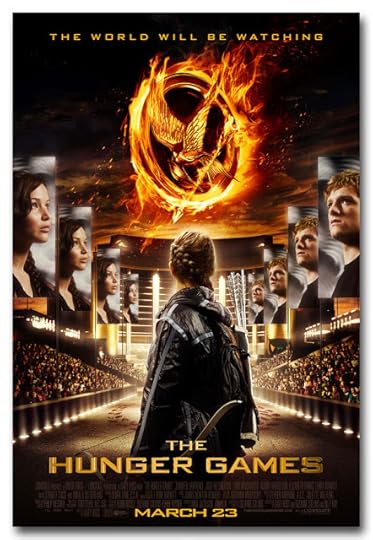
And finally, because Allie had finished the first book in the series, we watched "The Hunger Games." As a big fan of the Japanese teen-slaughter movie "Battle Royale" (read my review here, and listen to our Out of Theaters episode here), I couldn't help but compare the two. And yes, I realize a big-budget PG-13 movie based on a blockbuster teen novel isn't going to be as extreme as its Japanese counterpart, but I was amazed at (a) how tepid this movie was and (b) how little it explored its own central concept. If our hero, Katniss (Jennifer Lawrence, fine, I guess) is placed in a kill-or-be-killed situation, shouldn't she at some point have to actually, you know, kill someone, and then have to live with the consequences? Instead, the badguys are killed for her, and she gets to remain the pristine teen at the center of all the action. The movie is remarkably short on conflict and much more concerned with fashion, glamour and the high life of the rich folks watching the games instead of the poor folks playing them. Naturally, I realize this is why the books and movies are so insanely popular, and soaking the thing in blood like "Battle Royale" would alienate its young audience (including my daughter). But blood and gore aside, you could still make a compelling teen movie that death with some of the more uncomfortable themes inherent in this concept. Too bad they didn't.

Maybe you've heard of Red Letter Media, the Wisconsin company led by Mike Stoklasa and Jay Bauman. They're the guys who produced all those hilarious -- and surprisingly accurate -- videos dissecting every single way that the "Star Wars" prequels fail as movies, as entertainment and as a continuation of Lucas' legacy. Stoklasa narrated those as the gravelly voiced "Mr. Plinkett," but in this sci-fi satire he and Bauman step back and let Rich Evans take center stage as "Space Cop," an incompetent, lazy, slow-witted law officer of the future. When he arrives in the present day, he's teamed up with a cryogenically frozen cop from the past (Stoklasa) and together, they have to battle an alien invasion (which includes Bauman, somehow). "Space Cop" is a crude, dopey comedy, but it's also very funny, and it's smart in the way it plays with the cliches of the genre. All three actors have fun with their roles, and you can bet your life it's better than whatever Adam Sandler or Kevin James epic is lurking down at your local multiplex. Want to watch it? Order it here.

I had high hopes for this one, I really did. I'm fascinated by the whole concept of the futuristic outlook of the World's Fair, which this movie draws from. I've never seen a movie by director Brad Bird that I didn't like. (He's the guy behind "Iron Giant," "The Incredibles," Mission Impossible: Ghost Protocol" and "Ratatouille," in case you didn't know. And I've always thought George Clooney went out of his way to pick interesting projects. So clearly, "Tomorrowland" was all me. Except, somehow, it just didn't work. None of the elements -- the futuristic city, the strangely pessimistic undertone, the (admittedly impressive) special effects or the various characters -- came together. There's a lot going on, but it just doesn't add up in the end, and it definitely doesn't have the emotional impact the filmmakers were shooting for. So much of it didn't make sense (The Eiffel Tower is a rocket base?) or was poorly explained (Just where was Tomorrowland, anyway?) that though it looked good, it left a big feeling of disappointment behind. Too bad. So much potential.

And finally, because Allie had finished the first book in the series, we watched "The Hunger Games." As a big fan of the Japanese teen-slaughter movie "Battle Royale" (read my review here, and listen to our Out of Theaters episode here), I couldn't help but compare the two. And yes, I realize a big-budget PG-13 movie based on a blockbuster teen novel isn't going to be as extreme as its Japanese counterpart, but I was amazed at (a) how tepid this movie was and (b) how little it explored its own central concept. If our hero, Katniss (Jennifer Lawrence, fine, I guess) is placed in a kill-or-be-killed situation, shouldn't she at some point have to actually, you know, kill someone, and then have to live with the consequences? Instead, the badguys are killed for her, and she gets to remain the pristine teen at the center of all the action. The movie is remarkably short on conflict and much more concerned with fashion, glamour and the high life of the rich folks watching the games instead of the poor folks playing them. Naturally, I realize this is why the books and movies are so insanely popular, and soaking the thing in blood like "Battle Royale" would alienate its young audience (including my daughter). But blood and gore aside, you could still make a compelling teen movie that death with some of the more uncomfortable themes inherent in this concept. Too bad they didn't.
Published on March 07, 2016 17:38
February 22, 2016
The Greatest Music Book You've Never Heard Of
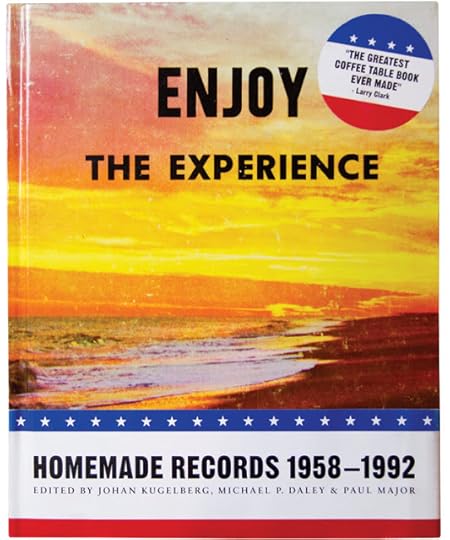 As I may have mentioned once or twice on this blog, I have more than a few movie books in my library. But, as I may not have mentioned, I have more than a few music books, too, including most of the basics -- Lester Bang's "Psychotic Reactions and Carburetor Dung," Nick Tosches' "Dino," whatever that giant history of rock 'n' roll is that Rolling Stone put out decades ago and I picked up at a library book sale. But I've also got a few more obscure items, too, volumes examining the hidden corners of popular music where mainstream critics fear to tread. And my current favorite among those tomes is a pretty massive coffee table book called "Enjoy the Experience: Homemade Records 1958-1992." Edited by John Kugelberg and released a couple of years ago, it's the sort of oddball book I can barely believe exists, but one I'm sure grateful does.
As I may have mentioned once or twice on this blog, I have more than a few movie books in my library. But, as I may not have mentioned, I have more than a few music books, too, including most of the basics -- Lester Bang's "Psychotic Reactions and Carburetor Dung," Nick Tosches' "Dino," whatever that giant history of rock 'n' roll is that Rolling Stone put out decades ago and I picked up at a library book sale. But I've also got a few more obscure items, too, volumes examining the hidden corners of popular music where mainstream critics fear to tread. And my current favorite among those tomes is a pretty massive coffee table book called "Enjoy the Experience: Homemade Records 1958-1992." Edited by John Kugelberg and released a couple of years ago, it's the sort of oddball book I can barely believe exists, but one I'm sure grateful does.In it its more than 500 pages, "Enjoy the Experience" collects thousands of album covers by artists you've never heard of. Artists I've never heard of. Artists, in fact, that virtually no one has ever heard of. Let me put it in perspective: Have you ever heard of The Shaggs, a group of three sisters (Betty, Helen and Dot Wiggin) whose father funded a self-produced album called "Philosophy of the World" back in 1969 that has since become an underground classic thanks to its combination of heartfelt emotion and amazing amateurism? Well, The Shaggs are the most famous group in "Enjoy the Experience" by a long shot. Compared to the rest of the nightclub performers, religious crooners and backyard bands collected in these pages, The Shaggs might as well be the Beatles.
And that, my friends, is what makes this book such a thing of wonder. Page after page of forgotten artists, immortalized forever in LP cover art that tries to capture what made them special (if anything) in the first place. Describing it here or even sharing a couple of spreads (see below) can't begin to convey the sheer majesty of this book. I've had it for a couple of years now and paged through it a dozen times, but I feel like I've barely scratched the surface of the wonders held within.
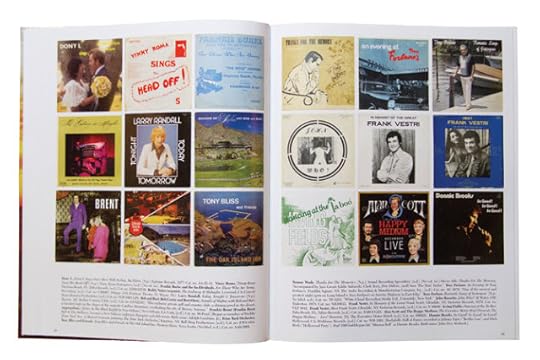
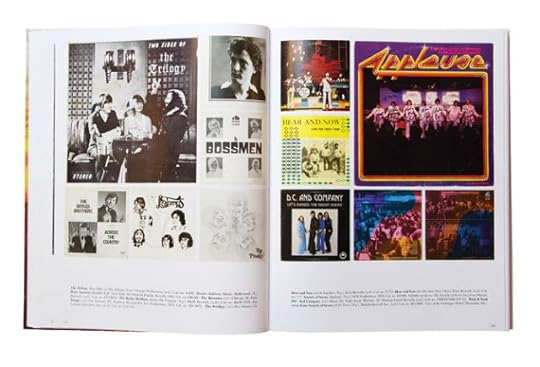 For one thing, besides those thousands of album covers, there are interviews with some of the visionary collectors who rescued these pop artifacts from thrift stores and garage sales. There are fascinating (and fascinatingly dense) excerpts from the self-published catalogs of record dealer Paul Major, who uncovered much of this stuff. There are profiles of some of the artists, including the aforementioned Shaggs, Miami nightclub mainstay Lee Sohn, family group The Rhodes Kids, and L.A. duo 33 1/3, also known as Lightstorm, also known as Teeth, also known as Jonema and Kalassu, collaborators and lovers who made the semi-legendary (and completely amateur) horror movie "Boarding House," which is the cinematic equivalent of most of the albums in this book. The bios, which are surprisingly extensive, go beyond the music itself, painting a vivid portrait of these people who never made it rich, and barely made a living, but never stopped making music. It's more than interesting -- it's oddly inspiring.
For one thing, besides those thousands of album covers, there are interviews with some of the visionary collectors who rescued these pop artifacts from thrift stores and garage sales. There are fascinating (and fascinatingly dense) excerpts from the self-published catalogs of record dealer Paul Major, who uncovered much of this stuff. There are profiles of some of the artists, including the aforementioned Shaggs, Miami nightclub mainstay Lee Sohn, family group The Rhodes Kids, and L.A. duo 33 1/3, also known as Lightstorm, also known as Teeth, also known as Jonema and Kalassu, collaborators and lovers who made the semi-legendary (and completely amateur) horror movie "Boarding House," which is the cinematic equivalent of most of the albums in this book. The bios, which are surprisingly extensive, go beyond the music itself, painting a vivid portrait of these people who never made it rich, and barely made a living, but never stopped making music. It's more than interesting -- it's oddly inspiring.I suppose one could flip through these pages and have some cheap laughs. After all, most of these LP covers are at least a little bit ridiculous, whether it's the tearful clown holding a cracked Earth on Roy Waldrop's "Heart of a Clown" or the misspelling on the trying-to-be-scary cover of "Satan and Deciples." There are pages of the book devoted to dozens of albums using the same, printer-supplied photos of sunsets, beaches and sunsets on beaches. And there's the plain old strange stuff, like the handful of painstakingly drawn magic marker covers (not printed -- drawn) or the album by a woman named Helen Hayes that says -- in huge letters, on the cover "NOT THAT HELEN HAYES." It's definitely amusing, and potentially hilarious.
But it's also more than that. Editor John Kugelberg and his collaborators take care to showcase these LPs and the stories behind them in a way that reminds you that every single record in this book was created by someone who was trying to say something, who was trying to make something. It might sound silly (or worse, pretentious) to call this "folk art," but that's exactly what it is, art created by people outside the mainstream who make up in determination and vision what they might lack in talent (or, for that matter, taste). When I page through "Enjoy the Experience" -- and I find myself doing so frequently -- I wonder about these people, who they are, why they made these LPs and what they're doing now. More than that, it's inspired me to check out my local thrift stores and used record stores, seeing if any similar treasures can be found amidst the endless Bill Cosby albums (sure are a lot of those lately). And my hunting has been rewarded -- not long ago, I picked up a copy of The Rhodes Kids "Live at the Las Vegas Hilton" autographed by all seven members of the band! Is the music any good? Well, not really. It's your basic mid-level, family-friendly Vegas act. But as an artifact, the album itself is one of a kind.
There is an album collecting several tracks by these artists, by the way, available on CD and (of course) vinyl. I've got it, and I highly recommend it. The songs are never less than interesting, and occasionally they're legitimately great ("6.4=Make Out" by Gary Wilson is especially mesmerizing). Plus, the liner notes are extensive and revealing, letting you know just who created the strange sounds going into your ears. If this sounds at all interesting to you, definitely get your hands on a copy.
But even more than that, get this book. I realize spending more than 60 bucks on a coffee table book full of photos of obscure band sounds insane, but trust me on this. If you're in the right mood, and the book hits you at the right time, it's more than sane. It's a life-changing experience.
Published on February 22, 2016 19:27
February 14, 2016
Movies I Watched in January
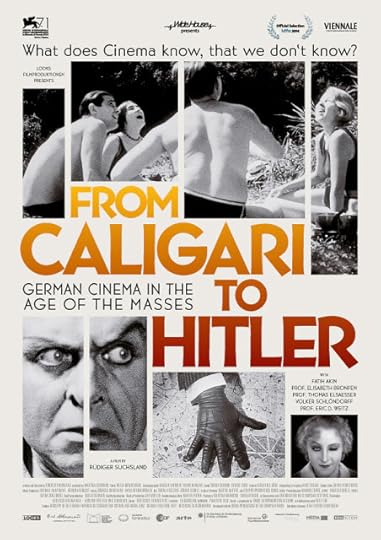
When I was a college freshman at Kent State, back in the mid 1980s, the book "From Caligari to Hitler: A Psychological History of German Film" was sitting there on the library shelf, waiting for me to pick it up. Trouble is, I was just a dumb freshman, and though I read a lot of movie books, they were more along the lines of "The Psychotronic Encyclopedia of Film" and "Incredibly Strange Films." A psychological study of a cinema in a foreign language looked like a little more than I wanted to bite off back then, and even as my movie research became increasingly arcane, I never got around to reading the book. Thankfully, Rudiger Suchsland made a documentary based on it in 2014, and even more thankfully, Netflix added it to its own increasingly arcane selection of documentaries. Resubtitled "Cinema in the Age of the Masses," the doc "From Caligari to Hitler" covers German cinema during the Weimar Republic, which delivered some amazing masterpieces between the years when German lost World War I and when it began gearing up for II. If movies were invented as a process in France and as a business in the United States, an argument can be made that they were invented as an artform in Germany, and this movie offers ample proof in the form of interviews, anecdotes and, best of all, clips. I'm sure the book version goes into much more analytical detail, but there's nothing like visual evidence, and Suchsland's film delivers plenty. There are selections from classics, of course, like "The Cabinet of Dr. Caligari," Lang's "Metropolis" and "Mabuse" films and Murnau's "Faust," but we also get fascinating glimpses of "Berlin, Symphony of a Metropolis" and "People on Sunday," films that show how vibrant and alive Germany was, artistically, before everything went horribly wrong. It's a great watch, whether you're a fan of history, of movies or both.
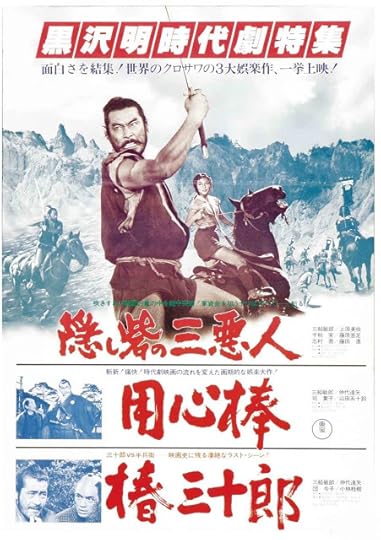 And speaking of foreign films made by Axis Powers... I wrote this one up for an episode of our Out of Theaters podcast. Short description: Though everyone knows "The Hidden Fortress" as one of the inspirations of George Lucas' original "Star Wars," it's much more than that, a rousing adventure from Akira Kurosawa that's enjoyable regardless of any connections it might have to Lucas' film. Long description?
Read it here.
And speaking of foreign films made by Axis Powers... I wrote this one up for an episode of our Out of Theaters podcast. Short description: Though everyone knows "The Hidden Fortress" as one of the inspirations of George Lucas' original "Star Wars," it's much more than that, a rousing adventure from Akira Kurosawa that's enjoyable regardless of any connections it might have to Lucas' film. Long description?
Read it here.
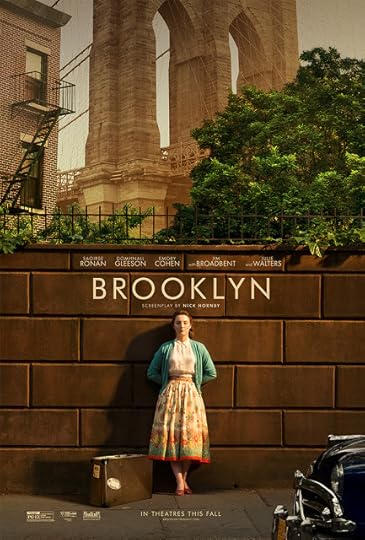 A beautifully made, surprisingly effective, almost shockingly simple movie about Eilis, an Irish lass (Saoirse Ronan, proving she's probably the best actress of her generation) traveling to America in the 1950s and trying to make a life for herself. That's it. No unbelievable plot twists, no scheming villains, no impact on anyone but a handful of characters. And yet it's really something to see, beautifully filmed (direction by John Crowley, cinematography by Yves Belanger) and even more beautifully acted with Ronan in the center surrounded by subtle, affecting performances by Jim Broadbent, Maeve McGrath, Julie Walters and, as Eilis' suitors, Emory Cohen (as the Brooklyn guy) and Domhnall Gleason (who's in every movie made these days, apparently). By avoiding the cliche of making one of the suitors the "bad" guy, "Brooklyn" generates real suspense about whom Eilis will choose, and when she makes her decision, it's staged beautifully, as a calm response that reveals decades of anger and frustration. My wife and I saw this movie one Sunday, choosing between it and "The Revenant," and it's hard to imagine two more different movies that both take place on planet Earth. You've heard about (and probably seen) "The Revenant." Now see this.
A beautifully made, surprisingly effective, almost shockingly simple movie about Eilis, an Irish lass (Saoirse Ronan, proving she's probably the best actress of her generation) traveling to America in the 1950s and trying to make a life for herself. That's it. No unbelievable plot twists, no scheming villains, no impact on anyone but a handful of characters. And yet it's really something to see, beautifully filmed (direction by John Crowley, cinematography by Yves Belanger) and even more beautifully acted with Ronan in the center surrounded by subtle, affecting performances by Jim Broadbent, Maeve McGrath, Julie Walters and, as Eilis' suitors, Emory Cohen (as the Brooklyn guy) and Domhnall Gleason (who's in every movie made these days, apparently). By avoiding the cliche of making one of the suitors the "bad" guy, "Brooklyn" generates real suspense about whom Eilis will choose, and when she makes her decision, it's staged beautifully, as a calm response that reveals decades of anger and frustration. My wife and I saw this movie one Sunday, choosing between it and "The Revenant," and it's hard to imagine two more different movies that both take place on planet Earth. You've heard about (and probably seen) "The Revenant." Now see this.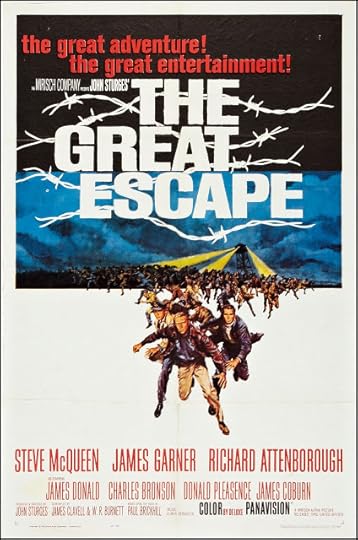 I wrote all about it for the Out of Theaters podcast
here
. Please click and read it -- I really don't want to paste the same text here at X-Ray Spex. And hey, while you're there -- listen to the episode!
I wrote all about it for the Out of Theaters podcast
here
. Please click and read it -- I really don't want to paste the same text here at X-Ray Spex. And hey, while you're there -- listen to the episode!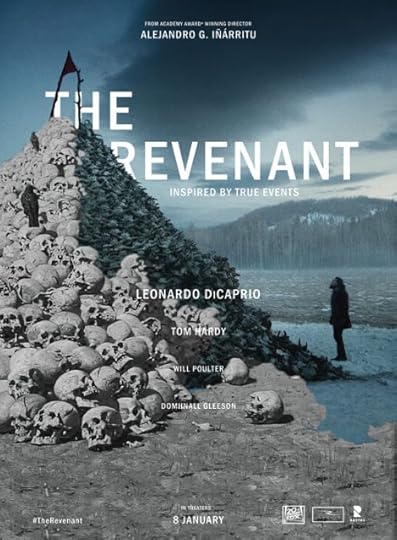 It wasn't the best movie I saw in 2015 (even though I saw it in 2016 -- but I think you know what I mean), but it was the most punishing, a brutal, sometimes thrilling, sometimes deadening travelogue of the American northwest -- complete with jaw-dropping violence, beautiful cinematography and an instantly classic scene of not-bear-rape. It was an invigorating experience, that's for sure, and it certainly showed me plenty I'd never before seen, but in the end, I'm not quite sure what it all added up to. Not exactly deep, in other words. Sort of like "There Will Be Blood," but without the strong characters and thematically underpinning. Still, it's hard to complain about a movie that stuns you (sometimes into submission) at least once every couple minutes. If you can stand a bit of violence (the opening is like "Saving Private Ryan" restaged with bows and arrows) and don't feel too sympathetic towards horses (they get treated especially brutally), go see "The Revenant" on the biggest screen you can find. It's certainly an experience. That, I think, we can agree on.
It wasn't the best movie I saw in 2015 (even though I saw it in 2016 -- but I think you know what I mean), but it was the most punishing, a brutal, sometimes thrilling, sometimes deadening travelogue of the American northwest -- complete with jaw-dropping violence, beautiful cinematography and an instantly classic scene of not-bear-rape. It was an invigorating experience, that's for sure, and it certainly showed me plenty I'd never before seen, but in the end, I'm not quite sure what it all added up to. Not exactly deep, in other words. Sort of like "There Will Be Blood," but without the strong characters and thematically underpinning. Still, it's hard to complain about a movie that stuns you (sometimes into submission) at least once every couple minutes. If you can stand a bit of violence (the opening is like "Saving Private Ryan" restaged with bows and arrows) and don't feel too sympathetic towards horses (they get treated especially brutally), go see "The Revenant" on the biggest screen you can find. It's certainly an experience. That, I think, we can agree on.
Published on February 14, 2016 10:36
January 26, 2016
Buy My Comics, Make Me Rich: TEEN TITANS #16
This is going to be the last one of these posts I write for the foreseeable future, because my run on DC's TEEN TITANS comes to an end with the 16th issues. I don't have any definite assignments on my calendar, but I've put some lines out and there have been a few nibbles (and if you happen to be a comics publisher who's reading this blog, feel free to get in touch). But, until the day my hard-to-spell name once again graces the credits page of a comic, there's one more issue of TITANS -- and it's a good one, if I do say so myself.
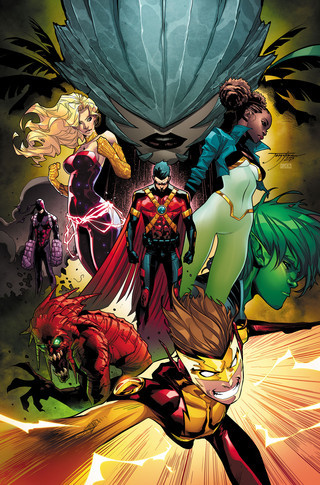
With a script by yours truly, pencils by Miguel Mendonca, inks by Dexter Vines, letters by Cory Breen, colors by Tony Avina and edits by Paul Kaminski, Mike Cotton and Eddie Berganza, it's an action-packed issue the finds our Titans recovering from the battle with Professor Pyg in TEEN TITANS #15 when, all of a sudden, they're attacked by an alien attack squad looking to bring their Durlan friend Chimera back to her home planet.
Everyone gets a chance to show off their powers, with Beast Boy transforming into my daughter's favorite animal in the whole wide world, the South American fish the Arapaima, beautifully drawn by Miguel and Dexter...
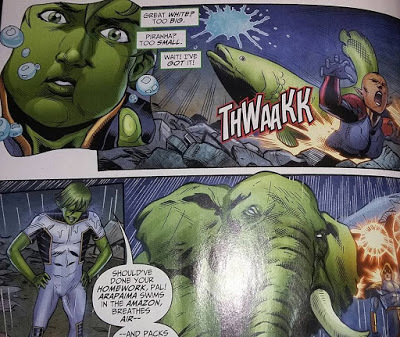
If you're more of a primate person, you also get to see Beast Boy take chimp form and give the Gotham City Police Department the two-fingered salute -- but you're going to have to buy the book to catch a glimpse of that. You can, however, read the first several pages of the issue here.
TEEN TITANS #16 comes wrapped in a cover by Jorge Jimenez and Alejandro Sanchez (seen above), but if you're into that whole adult coloring book thing, there's a variant by Timothy Green II (below) that you finish with your own markers, colored pencils or box of Crayolas. In fact, why not take it to your local comic book convention and see if any visiting colorists will add their distinctive touch?
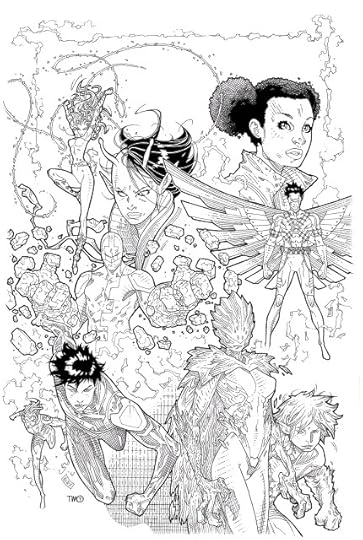
I've had a great time working on TEEN TITANS, and hope you're enjoyed the ride as well. Thanks for all who've been reading it for the past year and a half, and special thanks to my editors Mike, Paul and Eddie (plus a special bonus thanks to former associate editor Rickey Purdin). Guys, it's been a blast!

With a script by yours truly, pencils by Miguel Mendonca, inks by Dexter Vines, letters by Cory Breen, colors by Tony Avina and edits by Paul Kaminski, Mike Cotton and Eddie Berganza, it's an action-packed issue the finds our Titans recovering from the battle with Professor Pyg in TEEN TITANS #15 when, all of a sudden, they're attacked by an alien attack squad looking to bring their Durlan friend Chimera back to her home planet.
Everyone gets a chance to show off their powers, with Beast Boy transforming into my daughter's favorite animal in the whole wide world, the South American fish the Arapaima, beautifully drawn by Miguel and Dexter...

If you're more of a primate person, you also get to see Beast Boy take chimp form and give the Gotham City Police Department the two-fingered salute -- but you're going to have to buy the book to catch a glimpse of that. You can, however, read the first several pages of the issue here.
TEEN TITANS #16 comes wrapped in a cover by Jorge Jimenez and Alejandro Sanchez (seen above), but if you're into that whole adult coloring book thing, there's a variant by Timothy Green II (below) that you finish with your own markers, colored pencils or box of Crayolas. In fact, why not take it to your local comic book convention and see if any visiting colorists will add their distinctive touch?

I've had a great time working on TEEN TITANS, and hope you're enjoyed the ride as well. Thanks for all who've been reading it for the past year and a half, and special thanks to my editors Mike, Paul and Eddie (plus a special bonus thanks to former associate editor Rickey Purdin). Guys, it's been a blast!
Published on January 26, 2016 17:25
January 24, 2016
Movies I Watched in December, Part 2
The month of January is almost over, so I guess it's high time I finally wrote about what I watched a month earlier.
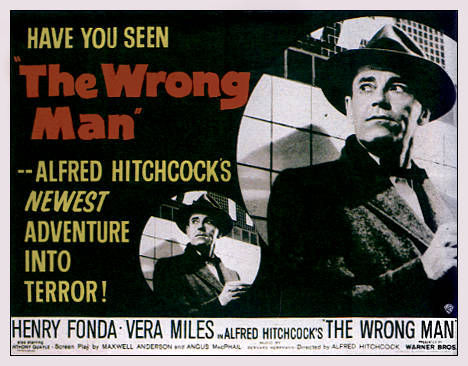
I've seen most Hitchcock movies, but for some reason I'd never seen this 1956 fact-based drama about a musician (Henry Fonda) falsely accused of a series of robberies. It's more low-key and realistic than say, "Psycho," but that's one of its major strengths. You can feel the net of coincidences twisting more and more tightly on poor Henry, and at times it reminded me of "Making A Murderer." (Though, this being a 1956 film, the morality was a lot more black-and-white -- you never doubt for a minute that Henry, loving husband and father, is innocent. Still, until the ending (which is a little too neat and tidy), there's some real suspense generated -- and you get a fascinating, matter-of-fact tour of the mid-fifties criminal justice system.
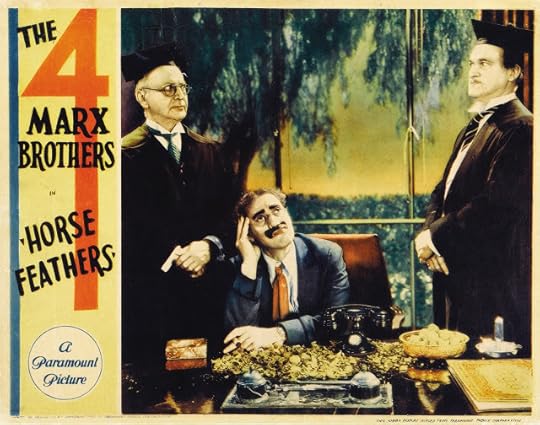
Yes, "Horsefeathers" again. Allie wanted to watch it, and who am I to say no? A, I love the movie (like I've said before, I think it's probably, laugh-for-laugh, the most purely funny Marx Brothers movie), and B, in no time that daughter of mine is going to be obsessed with a load of modern pop culture that I have no connection to (or, I'm predicting, interest in). So as long as she's in, I'm in.
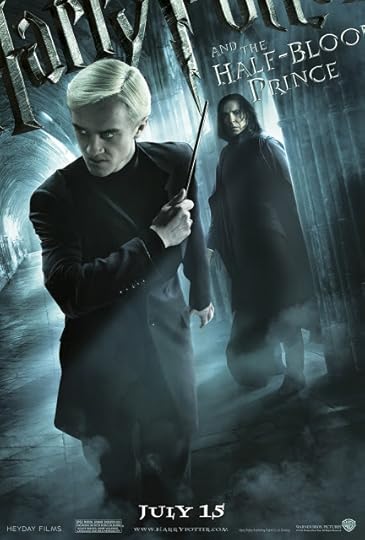
Speaking of modern pop culture, Harry Potter has been Allie's obsession for a while now. She plowed through all the books in record time, and now she's working her way through the movies. I've seen them all, but it's been awhile, and I have to admit, I can't quite remember what happens in which one. This is the one where, SPOILERS, Dumbledore dies, and the series takes an increasingly dark turn. They're pretty good movies, actually, and part of the credit goes to whoever decided to hire virtually every talented British actor to fill out the faculty at Hogwarts. When Alan Rickman died, I said on Twitter that to me he'll always be Hans Gruber (from "Die Hard," of course) but for Allie, he'll always be Professor Snape. The day he passed, Allie re-read a Snape-centric passage in one of the novels, which I felt was a nice little tribute.

I've seen most Hitchcock movies, but for some reason I'd never seen this 1956 fact-based drama about a musician (Henry Fonda) falsely accused of a series of robberies. It's more low-key and realistic than say, "Psycho," but that's one of its major strengths. You can feel the net of coincidences twisting more and more tightly on poor Henry, and at times it reminded me of "Making A Murderer." (Though, this being a 1956 film, the morality was a lot more black-and-white -- you never doubt for a minute that Henry, loving husband and father, is innocent. Still, until the ending (which is a little too neat and tidy), there's some real suspense generated -- and you get a fascinating, matter-of-fact tour of the mid-fifties criminal justice system.

Yes, "Horsefeathers" again. Allie wanted to watch it, and who am I to say no? A, I love the movie (like I've said before, I think it's probably, laugh-for-laugh, the most purely funny Marx Brothers movie), and B, in no time that daughter of mine is going to be obsessed with a load of modern pop culture that I have no connection to (or, I'm predicting, interest in). So as long as she's in, I'm in.

Speaking of modern pop culture, Harry Potter has been Allie's obsession for a while now. She plowed through all the books in record time, and now she's working her way through the movies. I've seen them all, but it's been awhile, and I have to admit, I can't quite remember what happens in which one. This is the one where, SPOILERS, Dumbledore dies, and the series takes an increasingly dark turn. They're pretty good movies, actually, and part of the credit goes to whoever decided to hire virtually every talented British actor to fill out the faculty at Hogwarts. When Alan Rickman died, I said on Twitter that to me he'll always be Hans Gruber (from "Die Hard," of course) but for Allie, he'll always be Professor Snape. The day he passed, Allie re-read a Snape-centric passage in one of the novels, which I felt was a nice little tribute.
Published on January 24, 2016 14:03
January 17, 2016
What I'm looking forward to in 2016
High-RiseGod only knows if this movie will ever play in Rockford, but whether it's on the big screen or on Blu-ray, I'm dying to see this adaptation of the surreal, violent novel by J.G. Ballard. Set inside an apartment/total living complex where society breaks down and insanity erupts, the novel is full of wonderfully conceived bits of disturbing horror (the opening sentence has our hero eating a dog) and I can't wait to see them brought to life. One reason I'm especially excited about the movie is that its directed by Ben Wheatley, who also helmed "Kill List," a surprising and unnerving little thriller I wrote about here. Plus, Tom Hiddleston seems like the perfect actor to play our narrator, and Jeremy Irons is always good for creepy support. Best of all, it's a period piece, set smack in the mid 1970s. Just check out this trailer, which makes the most of Tangerine Dream's synth theme for "Risky Business"...
Comics as Art: We Told You So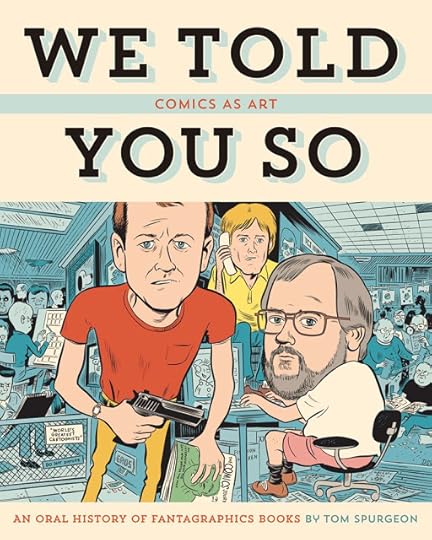
How long have I been looking forward to this history of Fantagraphics (publisher of Love & Rockets, Eightball, Hate, The Comics Journal and many other magazines and comics)? So long that I mentioned it on a similar list nine years ago. Every other book has appeared except that one (some many years ago), but apparently a threatened lawsuit on the part of the ever litigious Harlan Ellison kept this one from hitting the press. Thankfully, whatever problems Fantagraphics was dealing with have been solved, and the book (a massive 500-page hardcover) is due out in July. I've waited this long; what's another six months?
Patience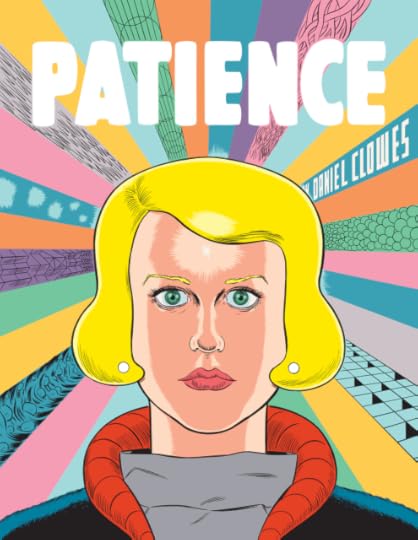
Speaking of Fantagraphics, Dan Clowes, creator of the aforementioned Eightball, is returning to the publisher with his latest work, a "psychedelic science fiction love story." Clocking in at 180 page and in full color, the book is hyped as offering "Clowes the opportunity to draw some of the most exuberant and breathtaking pages of his life." Hype or not, Clowes is one of the greatest cartoonists working today, and anything he does is worth checking out. This seems like it could be among his best work, and it's due in just over two months.
Beat Girls, Love Tribes and Real Cool Cats: Pulp Fiction and Youth Culture from the 1950s to the 1980sI admit I don't know much about this book, but it looks completely up my alley. An extensive (and extensively illustrated) history of paperback culture, it's described by co-author Andrew Nette as the "first comprehensive account of the rise of youth culture and mass-market paperback fiction in the postwar period in the US, UK and Australia. It is not just a comprehensive selection of covers, but an in-depth look at the authors, how they worked and what influenced them. It is a must-read for anyone interested in retro and subcultural style and popular fiction." Hell, I'm in! Out this spring.

Comics as Art: We Told You So

How long have I been looking forward to this history of Fantagraphics (publisher of Love & Rockets, Eightball, Hate, The Comics Journal and many other magazines and comics)? So long that I mentioned it on a similar list nine years ago. Every other book has appeared except that one (some many years ago), but apparently a threatened lawsuit on the part of the ever litigious Harlan Ellison kept this one from hitting the press. Thankfully, whatever problems Fantagraphics was dealing with have been solved, and the book (a massive 500-page hardcover) is due out in July. I've waited this long; what's another six months?
Patience

Speaking of Fantagraphics, Dan Clowes, creator of the aforementioned Eightball, is returning to the publisher with his latest work, a "psychedelic science fiction love story." Clocking in at 180 page and in full color, the book is hyped as offering "Clowes the opportunity to draw some of the most exuberant and breathtaking pages of his life." Hype or not, Clowes is one of the greatest cartoonists working today, and anything he does is worth checking out. This seems like it could be among his best work, and it's due in just over two months.
Beat Girls, Love Tribes and Real Cool Cats: Pulp Fiction and Youth Culture from the 1950s to the 1980sI admit I don't know much about this book, but it looks completely up my alley. An extensive (and extensively illustrated) history of paperback culture, it's described by co-author Andrew Nette as the "first comprehensive account of the rise of youth culture and mass-market paperback fiction in the postwar period in the US, UK and Australia. It is not just a comprehensive selection of covers, but an in-depth look at the authors, how they worked and what influenced them. It is a must-read for anyone interested in retro and subcultural style and popular fiction." Hell, I'm in! Out this spring.

Published on January 17, 2016 17:43
January 13, 2016
Movies I Watched in December, Part 1
It's about halfway through January 2016, so I figured I might as well post what I saw in December 2015...
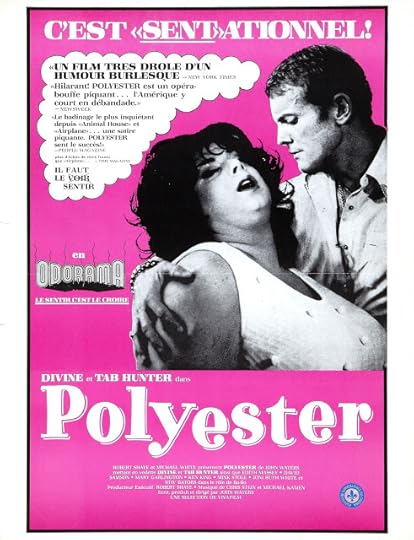
The last time I saw this movie also happened to be the first: Fall of 1985 during my freshman year of college, when Kent State showed it on campus, complete with Odorama cards and a question-and-answer session with director John Waters himself. The movie, which spoofs the 1950s melodramas of guys like Douglas Sirk (whom Waters, of course, is a huge fan of) has its moments, but these days it feels more like an interesting but awkward stepping stone between Waters’ early, outrageous (and usually X-rated) movies and the more mainstream fare that followed, like “Hairspray” (which I love – and wrote about here .) Focusing on the trials and tribulations of hapless Baltimore (of course) housewife Francine Fishpaw, “Polyester” is pretty uneven, mixing some solid jokes with long dead spaces and the sort of mean-spirited humor that worked better in movies like “Pink Flamingos,” when Waters and company could really go all out (and boy, did they ever). The best thing by far in “Polyester” is the central performance by Divine, channeling the spirit of late ‘60s Liz Taylor to deliver something that goes gloriously, outrageously over the top, back to the bottom again, then back over the top. It’s worth watching for Divine and Tab Hunter’s romance alone, which doesn’t seem quite so outlandish as it did back in 1981, when “Polyester” first hit screens.
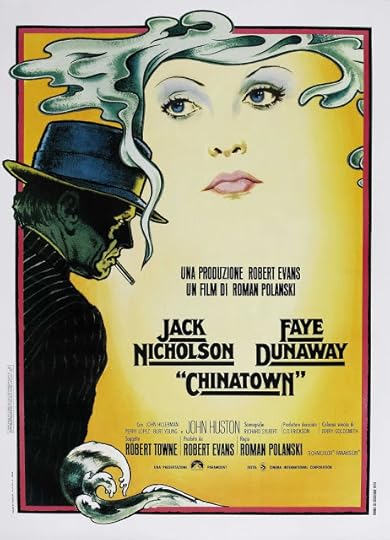
We watched this one for our Out of Theaters podcast (listen to the episode here ), and though the discussion eventually turned to the life of director Roman Polanski, the movie itself generated plenty of interesting talk – and no wonder, it’s still one of the high points of 1970s cinema. Here’s part of what I wrote over at the Out of Theaters site – if you want to read more, visit the site itself...
More than 40 years after it hit screens, “Chinatown” remains fascinating because it’s a study in contrasts. It’s a prestigious, big budget picture that deals with the worst of humanity. It’s a picture postcard of 1930s Los Angeles that focuses on the corruption and lies that made the city possible. It’s a movie full of great actors where two of the most memorable performances are by directors (Polanski as a knife-wielding thug and the legendary John Huston as the monstrous Noah Cross.) And, on top of all that, it’s a movie where the dark events on the screen pale in comparison to the dark events that happened off the screen — before and after the movie was made.
Towne and Polanski disagreed over the ending of “Chinatown.” I won’t spoil it here, except to say that Towne wanted to end things on a somewhat dark note, and Polanski wanted to end things on an existentially bleak dark note. Polanski, who saw his parents killed in the Holocaust and his wife killed by the Manson Family, can be forgiven for having a dark view of humanity. Whether he can be forgiven for the notorious rape he committed in 1977, three years after “Chinatown,” is another matter entirely — and it’s not a matter we ignore on this episode of Out of Theaters. In what may be our darkest episode, we delve deeply into the mysteries of “Chinatown” and the man who directed it. We also ask the question “If an artist commits a horrible crime, can you still admire the art?”
And please, if you’re one of the people actually reading these monthly movie recaps, I urge you (hell, I beg you) to give the podcast a listen. We’re really proud of what we’re doing, combining actual film discussion with humor, trivia and contrasting opinions.
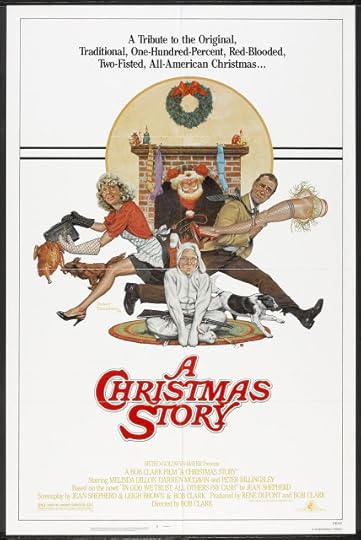
Somehow, amidst all the chaos of Christmas Eve, we managed to squeeze in a showing of this during its annual TBS maration. (Missing the first couple of minutes, I was able to catch those by sticking around after the end credits, thus obeying the anal-retentive rules I’ve established for myself on this movie list.) It’s fun, of course, really probably much better than it actually has to be. Any Christmas movie could’ve become an annual 24-hour tradition for some station looking to fill dead air, and we can be glad it was Bob Clark’s 1980 yuletide comedy and not some cinematic atrocity like, say, that “Grinch Who Stole Christmas Movie.” Clark’s movie, based on Jean Shepard’s short stories (and narrated by Shepard himself) is the perfect mix of warm nostalgia, goofy comedy and just the right touch of genuine sentiment. (My favorite example of the last is the glee Darrin McGavin has on his face watching his son open his Red Ryder BB Gun.) Once a year for “A Christmas Story” is enough, but I’m damned glad there’s an effortless (almost unavoidable) way to watch it that one time. Makes me wonder, though, in the right hands, could a similar story set in, say, the 1970s, be equally funny and charming? Time to fire up my copy of Final Draft and find out!
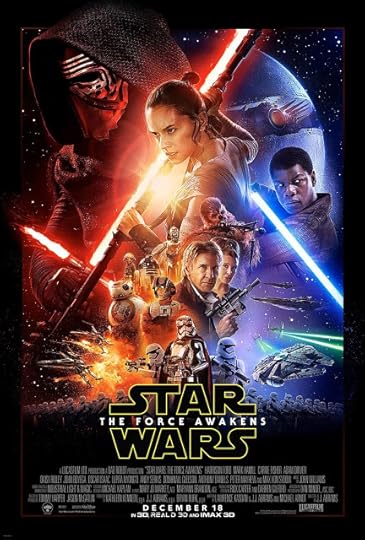
I wrote about it – a lot – right on this blog. Scroll down to the previous post when you’ve got a few hours to spare. Also, even though it's definitely not out of theaters (and probably won't be for a long, long time), we devoted an episode of the podcast to "The Force Awakens." Listen to it here .

The last time I saw this movie also happened to be the first: Fall of 1985 during my freshman year of college, when Kent State showed it on campus, complete with Odorama cards and a question-and-answer session with director John Waters himself. The movie, which spoofs the 1950s melodramas of guys like Douglas Sirk (whom Waters, of course, is a huge fan of) has its moments, but these days it feels more like an interesting but awkward stepping stone between Waters’ early, outrageous (and usually X-rated) movies and the more mainstream fare that followed, like “Hairspray” (which I love – and wrote about here .) Focusing on the trials and tribulations of hapless Baltimore (of course) housewife Francine Fishpaw, “Polyester” is pretty uneven, mixing some solid jokes with long dead spaces and the sort of mean-spirited humor that worked better in movies like “Pink Flamingos,” when Waters and company could really go all out (and boy, did they ever). The best thing by far in “Polyester” is the central performance by Divine, channeling the spirit of late ‘60s Liz Taylor to deliver something that goes gloriously, outrageously over the top, back to the bottom again, then back over the top. It’s worth watching for Divine and Tab Hunter’s romance alone, which doesn’t seem quite so outlandish as it did back in 1981, when “Polyester” first hit screens.

We watched this one for our Out of Theaters podcast (listen to the episode here ), and though the discussion eventually turned to the life of director Roman Polanski, the movie itself generated plenty of interesting talk – and no wonder, it’s still one of the high points of 1970s cinema. Here’s part of what I wrote over at the Out of Theaters site – if you want to read more, visit the site itself...
More than 40 years after it hit screens, “Chinatown” remains fascinating because it’s a study in contrasts. It’s a prestigious, big budget picture that deals with the worst of humanity. It’s a picture postcard of 1930s Los Angeles that focuses on the corruption and lies that made the city possible. It’s a movie full of great actors where two of the most memorable performances are by directors (Polanski as a knife-wielding thug and the legendary John Huston as the monstrous Noah Cross.) And, on top of all that, it’s a movie where the dark events on the screen pale in comparison to the dark events that happened off the screen — before and after the movie was made.
Towne and Polanski disagreed over the ending of “Chinatown.” I won’t spoil it here, except to say that Towne wanted to end things on a somewhat dark note, and Polanski wanted to end things on an existentially bleak dark note. Polanski, who saw his parents killed in the Holocaust and his wife killed by the Manson Family, can be forgiven for having a dark view of humanity. Whether he can be forgiven for the notorious rape he committed in 1977, three years after “Chinatown,” is another matter entirely — and it’s not a matter we ignore on this episode of Out of Theaters. In what may be our darkest episode, we delve deeply into the mysteries of “Chinatown” and the man who directed it. We also ask the question “If an artist commits a horrible crime, can you still admire the art?”
And please, if you’re one of the people actually reading these monthly movie recaps, I urge you (hell, I beg you) to give the podcast a listen. We’re really proud of what we’re doing, combining actual film discussion with humor, trivia and contrasting opinions.

Somehow, amidst all the chaos of Christmas Eve, we managed to squeeze in a showing of this during its annual TBS maration. (Missing the first couple of minutes, I was able to catch those by sticking around after the end credits, thus obeying the anal-retentive rules I’ve established for myself on this movie list.) It’s fun, of course, really probably much better than it actually has to be. Any Christmas movie could’ve become an annual 24-hour tradition for some station looking to fill dead air, and we can be glad it was Bob Clark’s 1980 yuletide comedy and not some cinematic atrocity like, say, that “Grinch Who Stole Christmas Movie.” Clark’s movie, based on Jean Shepard’s short stories (and narrated by Shepard himself) is the perfect mix of warm nostalgia, goofy comedy and just the right touch of genuine sentiment. (My favorite example of the last is the glee Darrin McGavin has on his face watching his son open his Red Ryder BB Gun.) Once a year for “A Christmas Story” is enough, but I’m damned glad there’s an effortless (almost unavoidable) way to watch it that one time. Makes me wonder, though, in the right hands, could a similar story set in, say, the 1970s, be equally funny and charming? Time to fire up my copy of Final Draft and find out!

I wrote about it – a lot – right on this blog. Scroll down to the previous post when you’ve got a few hours to spare. Also, even though it's definitely not out of theaters (and probably won't be for a long, long time), we devoted an episode of the podcast to "The Force Awakens." Listen to it here .
Published on January 13, 2016 17:37
December 29, 2015
'The Force Awakens': Risk, Remakes and the Next Generation
First of all, SPOILERS. For the whole movie. If you haven't seen it, don't read this.
OK? OK.
Second of all, let me just say this: I liked it. A lot. It was a smart, fast-paced movie that delivered the right amount of both thrills and emotional punches, and more often than not I found myself sitting there in the (packed) theater, a big goofy smile plastered on my face, enjoying the movie -- and, even more, enjoying the sight of my daughter, sitting next to me, enjoying the movie herself. I was 10 years old when I first saw "Star Wars" in the theater back in 1977, and her she was, 38 years later, 10 years old herself, watching her own first theatrical showing on "Star Wars." (She's seen the prequels on DVD, of course, but we're not counting that, are we? No we are not.)
I want to stress how much I enjoyed "The Force Awakens" right up front because I have the feeling that, after reading the rest of this post, you're going to think I didn't. And that's not the case. To repeat: It's a good movie. Arguably, in fact, a better movie than the original "Star Wars," though something like that is impossible to quantify for at least two reasons: 1. We live in a world that the original "Star Wars" has changed if not shaped, and any movie coming after it, especially one with the word "Star Wars" in its title, is living in the giant shadow (more on that later) that the original film cast. 2. Like I said, I saw "Star Wars" when I was 10 years old. I'm 48 now. No movie -- no matter how good it is -- can possibly have that kind of seismic impact.
Maybe that's why, as I was leaving the theater Sunday, big goofy smile still plastered on my face, replaying favorite moments in my head, I couldn't fight the nagging feeling that, as good as "The Force Awakens" is, it's not only destined to live in the shadow of its 1977 predecessor, it's actually designed to live in that shadow. I'm far from the first person to make this observation (my fellow Out of Theaters podcaster Kevin Haas writes about it here), but "The Force Awakens" is almost a beat-for-beat (if not scene for scene) remake of the original.
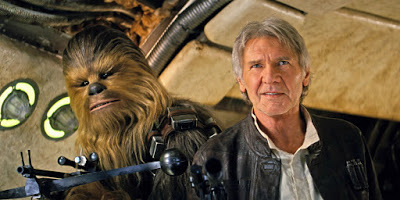
That's not necessarily a bad thing. The plot of "Star Wars" is neither complex nor original, and it's the perfect thing upon which to hang some interesting characters and groundbreaking special effect sequences. So when I realized "The Force Awakens" was going to give us basically the same story in a souped-up, self-referential form, I was OK with that. A droid with a secret hidden inside finds a new master on a desert plane, our heroes wind up in a bar looking for a way to get off-planet, Han Solo and chewy show up, the Empire (sorry, First Order) builds a planet-sized weapon and one of our young heroes flies an X-Wing fighter to destroy it. Also, there are light saber battles, a villain in a black cloak, a bigger villain who appears via hologram and the Millennium Falcon has mechanical problems before it's able to make a last-minute jump to hyperspace. I've seen it before. We all have. But that doesn't mean it's not a pleasure to see it again.
That's because director J.J. Abrams and writers Lawrence Kasdan and Michael Arndt (along with co-writer Abrams) have used that time-tested (timeworn?) setup to introduce us to characters with real potential. The original gang (who show up here, of course) were more character-types than actual characters -- the princess, the farmboy and the scoundrel -- but they were given distinctive life by actors Carrie Fisher, Mark Hamill and Harrison Ford. None of those were Oscar-caliber performances, but in each case, the actor brought something to the cliche, enough to keep us interested in them as we made the slide from childhood to adulthood. Luke, for instance, went from whiny to heroic in "Star Wars," but Hamill (who I don't think gets enough credit) made him genuinely compelling in "The Empire Strikes Back" and, especially, in "Return of the Jedi." I'd argue Luke is the best thing about that third movie, which (like "The Force Awakens") is a semi-remake of the original. In "Jedi," Luke goes from somebody pretending to be an ultra-cool mystic warrior in the beginning to someone who achieves actual gravitas and heroism by the end. When he throws away his light saber, refusing to kill Vader, it's a truly great moment, and Hamill plays it for all it's worth.
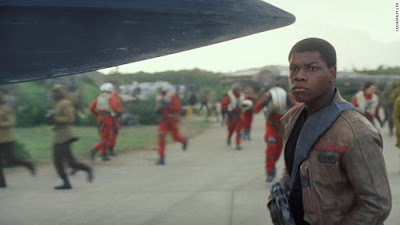
What makes "The Force Awakens" work so well is it has genuinely compelling characters played by actors who are probably stronger than anyone in the original films (except, of course, for Alec Guinness, though he was a bit of a ringer). Oscar Isaac, Daisy Ridley, John Boyega and Adam Driver deliver performances at least as good as anything we've seen in a "Star Wars" movie, and they're all so damned young they're probably only going to get better. What's more, whether it's the lack of Lucas-penned dialogue or the loose simplicity of the story (no trade disputes or senate maneuvering here), the actors actually seem to be having fun, and, for that matter, so do the characters. As Resistance pilot Poe Dameron, Isaac brings a big dose of the boyish glee that Luke had in spades, and it's hard not to smile whenever he's onscreen. He's such a refreshingly nice guy that you can feel the relief ex-Stormtrooper Finn (his jumping sides is the best concept in the movie) feels when he befriends him. And Ridley brings a nice sense of both mystery and determination to Rey. She's obviously got a troubled past, but she never gets mired in the pouty cliches of Anakin Skywalker. She's got the same never-say-die attitude as Luke had, and it's exciting watching her realize the Force flows through her, too.
Old friendsAnd, as for those old characters, they're used well, too. Harrison Ford is clearly the most popular actor to return, so it makes sense that Han Solo (and Chewbacca) would be the most involved in the actual action. What's more, Ford actually seems to be having fun with the role, and since he (SPOILERS) won't be around for any more installments, it's a pleasure having his character leave on a strong note. Carrie Fisher's General Leia (another nice touch) is doesn't have nearly as much to do, but it's nice to see her leading the troops again, and her scenes with Han have the same humorously romantic feel as the ones in "Empire" and "Jedi." What's more, it's frankly a pleasure seeing those characters as actual old people, with histories and stories that are hinted at but not described. And the fact that they did not, in fact, live happily ever after is a bonus.
I was half-expecting Luke not to show up at all in "The Force Awakens," but I was glad he did. Mark Hamill gets grief from "Star Wars" fans, but it's mostly for the single line of dialogue where he whines about the "power converters." As critics (and Hamill himself) have pointed out, Luke is supposed to be whiny, and his growth as a Jedi (and as a hero, and as a man) proceeds from that point. In this movie, the name "Luke Skywalker" is spoken in hushed tones, and his disappearance is seen by the younger characters as proof that he's more myth than man. Of course, Han, Leia and Chewie know differently, and his (SPOILERS) appearance in the last frames of the movie as Rey offers him his light saber is played in suitably mythic tones. Hamill looks every bit like a Jedi master in hiding, just like Obi Wan in "Star Wars," and his connection to Rey is one of the big mysteries the movie leaves us with. (Amazingly, Hamill is a year older than Alec Guinness was when he first played Obi-Wan back in 1977. Tempus fugit, boys and girls. Tempus fugit.)
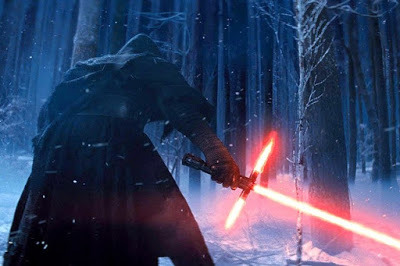
And the whole idea that our central villain -- Adam Driver's Kylo Ren -- is not only the son of (SPOILERS) Han and Leia but a failed Jedi who was (SPOILERS) being trained by Luke is one of the best things in the movie. It mirrors a good idea that the prequels completely screwed up (that Vader became Vader because Obi-Wan Kenobi was arrogant in thinking he could train him) and gives us a villain who's more than just another retread of Vader. Kylo Ren is both more sympathetic and more dangerous -- those much-mocked emo scenes of him wrecking rooms with his fiery light saber are one of the most interesting things about the film. They show someone struggling with his destiny (we've heard about people being tempted by the dark side before, but this is the first time someone's been tempted by the light side) and they even have a comedic payoff: When Kylo Ren tears apart the room Rey has escaped from, the two Stormtroopers headed his way quickly turn around to avoid dealing with him. (The re-humanizing of the Stormtroopers, from Finn's crisis of conscience to the behavior of those two, is another smart move by Abrams and Co.)
The light saber fight that concludes the movie is top-notch, right up there with the Luke-Vader battle at the end of "Empire." After all the meaningless waving of light sabers against green screens in the prequels, it's actually exciting to see a battle that (a) takes place in an actual location (or a reasonable facsimile) and (b) means something to the characters. The snowy background, the night setting and the surrounding forest give the scene a suitably fairy-tale feel, and the moment when the light saber leaps into Rey's hand is something we all knew was coming but damn, it sure felt right when it happened. And, thanks to the conveniently precise earthquake that separated Kylo Ren and Rey, our villain will obviously be making a comeback in episode VIII. Again, it's essentially the same thing that happened at the end of the original "Star Wars" -- remember Vader spinning away in his TIE Fighter? -- but it's the way a movie like this one should end: Death Star explodes, rebel base is saved, villain lives to fight another day. Yes, we've seen it before. That's OK. It still feels right the second (or third, or fourth) time around.

Plus, there was a lot that "The Force Awakens" got right. Even the references to the earlier movies, which have gotten some criticism in the nerdosphere, were well handled. My favorite was the way the Star Destroyer cast a shadow over an entire planet in the first scene (shades of the original opening), but the glimpses of the chess board, the light saber training gadget and the various bits of Imperial debris were fun -- and did you really expect Abrams and Co. to not include those references? It's been more than 30 years since we got a real Star Wars movie, and you can be damn sure the audience was craving that sort of thing, fan service or not. Plus, the two big callbacks -- the reveal of the Millennium Falcon and the unveiling of R2D2 -- managed to have a real emotional impact. That impact didn't have anything to do with the plot, or even with "The Force Awakens" itself. It was like seeing an old friend from childhood that you'd forgotten all about. Corny? Maybe, but you can't control how you connect to a movie, and for me (and a lot of people my age) the connection to the original "Star Wars" remains surprisingly strong after all these years.
But...As much as I liked the movie, this is the thing that keeps nagging me: "The Force Awakens," was a safe movie. It didn't take chances, and it didn't go in any unexpected directions -- not really. Now, that's not necessarily a criticism. Rebooting the entire franchise -- essentially resurrecting the very concept of "Star Wars" -- meant that caution was going to be the key word. Disney had a lot more at stake then the handful of billions they paid George Lucas for the rights to the movies. Also at stake were the many, many, many billions in potential profits the studio could reap over the coming decades -- as long as they didn't screw it up. With that much money on the table, no one was taking any chances. And so, while "The Force Awakens" is fun and entertaining and well-made and compelling and all the things it needs to be, there's one thing it's not. It's not surprising.
Sure, someone is bound to bring up the fact that (SPOILERS) Kylo Ren is Han and Leia's son, or that he actually ends up killing his father at the end, but be honest: Did either of those things really take you by surprise? Harrison Ford has been looking for a way to get out of "Star Wars" since "Empire" (he was frozen in carbonite in case he didn't return for "Jedi,") so it's not exactly a shock that in a movie designed to pass the baton to a younger cast, he makes a grand exit. The only reason his death surprised me is that somehow, against all odds, I'd manage to avoid hearing about it before seeing it happen on the screen.
When I walked out of the original "Star Wars," I was astonished. When I walked out of "The Force Awakens," I was entertained. Part of the blame lies with the fact that I'm 38 years older and have seen thousands of movies in that time. But part of the blame lies with the movie. As simple and straightforward as it seems now, "Star Wars" was a big risk for George Lucas. No one was clammoring for a science fiction movie in 1977, and it could have easily died at the box office. By the time 1980 rolled around and "Empire" was released, Lucas (and company) took another chance. The lighthearted thrills of "Star Wars" were replaced with something darker, where the heroes lost and the story didn't end. Three years later, "Jedi" wasn't as much of a surprise, which is why, in a strange way, it feels the most like "The Force Awakens" -- minus the Ewoks, of course. (The prequels, for all their many faults, actually were risky on the part of Lucas. But just because something is a risk doesn't mean it's good.) I'm betting we'll see things get a little riskier in 2017 with the release of Episode VIII. Now that the foundation's been built, director Rian Johnson ("Looper") and his team will be able to get a little stranger, even with Disney keeping close watch on its multi-billion dollar nest egg. At least I hope that's what happens.
SW: TNGBut I'm an old man who's seen a thousand movies (really, I have). What did my daughter, Allie, think? After all, now she's 10 years old and seeing her first "Star Wars" movie in the theater. If "The Force Awakens is aimed at anyone, it's aimed at her, right? So what's her verdict?
She loved it. Of course. Better than the prequels. Way, way better. And yet...
She wasn't blown away. She wasn't left shaking. And, so far, she hasn't asked about seeing it again. After I saw "Star Wars," that's all I wanted to do. But Allie, growing up in a world of streaming video and Blu-rays and everything she's ever wanted being available on her iPad? She's in no hurry to see "The Force Awakens" in the theater again. She knows that, before long, she'll be able to see it whenever she wants. Plus, there's one other thing. One final thing.
I've seen a lot of people on social media describing a situation similar to mine. They're taking their kids to see their first "Star Wars" movie in the theater and saying things like "This one is going to be her 'Star Wars.'" I said the same thing when I was taking Allie along. Now we could both have our "Star Wars," and she'd know the same excitement I felt in my childhood.
But I was wrong. This wasn't Allie's "Star Wars." She's already got her "Star Wars." It's "Guardians of the Galaxy." Or maybe "Harry Potter." Or "The Hunger Games." Or something she hasn't discovered yet. Expecting her to make "Star Wars" the central pop culture icon in her life is like expecting me to have the Beatles as my favorite band. It's a nice thought, but it's probably not going to happen. The pop culture you connect with is something you have to find for yourself -- or, more likely, something that has to find you. It's not something your parents can give you, no matter how much they want to. And that's fine. One of the nicknames for my age group is "the Star Wars Generation." Whether it fits or not isn't the point. The point is, we don't need another "Star Wars Generation." One is enough. Let the kids have their fun. Their own fun.
That doesn't mean we can't enjoy the movies, and that doesn't mean our kids can't enjoy them along with us. What it means is that as good as "The Force Awakens" is (and, like I said way back at the beginning of this post, it's very good) it's not "Star Wars," and it's never going to be "Star Wars."
And the year is never going to be 1977 again.
And, most of all, I'm never going to be 10 years old again.
But that's OK. My daughter is 10 years old, for now at least. She's at the perfect age ... for something.
OK? OK.
Second of all, let me just say this: I liked it. A lot. It was a smart, fast-paced movie that delivered the right amount of both thrills and emotional punches, and more often than not I found myself sitting there in the (packed) theater, a big goofy smile plastered on my face, enjoying the movie -- and, even more, enjoying the sight of my daughter, sitting next to me, enjoying the movie herself. I was 10 years old when I first saw "Star Wars" in the theater back in 1977, and her she was, 38 years later, 10 years old herself, watching her own first theatrical showing on "Star Wars." (She's seen the prequels on DVD, of course, but we're not counting that, are we? No we are not.)
I want to stress how much I enjoyed "The Force Awakens" right up front because I have the feeling that, after reading the rest of this post, you're going to think I didn't. And that's not the case. To repeat: It's a good movie. Arguably, in fact, a better movie than the original "Star Wars," though something like that is impossible to quantify for at least two reasons: 1. We live in a world that the original "Star Wars" has changed if not shaped, and any movie coming after it, especially one with the word "Star Wars" in its title, is living in the giant shadow (more on that later) that the original film cast. 2. Like I said, I saw "Star Wars" when I was 10 years old. I'm 48 now. No movie -- no matter how good it is -- can possibly have that kind of seismic impact.
Maybe that's why, as I was leaving the theater Sunday, big goofy smile still plastered on my face, replaying favorite moments in my head, I couldn't fight the nagging feeling that, as good as "The Force Awakens" is, it's not only destined to live in the shadow of its 1977 predecessor, it's actually designed to live in that shadow. I'm far from the first person to make this observation (my fellow Out of Theaters podcaster Kevin Haas writes about it here), but "The Force Awakens" is almost a beat-for-beat (if not scene for scene) remake of the original.

That's not necessarily a bad thing. The plot of "Star Wars" is neither complex nor original, and it's the perfect thing upon which to hang some interesting characters and groundbreaking special effect sequences. So when I realized "The Force Awakens" was going to give us basically the same story in a souped-up, self-referential form, I was OK with that. A droid with a secret hidden inside finds a new master on a desert plane, our heroes wind up in a bar looking for a way to get off-planet, Han Solo and chewy show up, the Empire (sorry, First Order) builds a planet-sized weapon and one of our young heroes flies an X-Wing fighter to destroy it. Also, there are light saber battles, a villain in a black cloak, a bigger villain who appears via hologram and the Millennium Falcon has mechanical problems before it's able to make a last-minute jump to hyperspace. I've seen it before. We all have. But that doesn't mean it's not a pleasure to see it again.
That's because director J.J. Abrams and writers Lawrence Kasdan and Michael Arndt (along with co-writer Abrams) have used that time-tested (timeworn?) setup to introduce us to characters with real potential. The original gang (who show up here, of course) were more character-types than actual characters -- the princess, the farmboy and the scoundrel -- but they were given distinctive life by actors Carrie Fisher, Mark Hamill and Harrison Ford. None of those were Oscar-caliber performances, but in each case, the actor brought something to the cliche, enough to keep us interested in them as we made the slide from childhood to adulthood. Luke, for instance, went from whiny to heroic in "Star Wars," but Hamill (who I don't think gets enough credit) made him genuinely compelling in "The Empire Strikes Back" and, especially, in "Return of the Jedi." I'd argue Luke is the best thing about that third movie, which (like "The Force Awakens") is a semi-remake of the original. In "Jedi," Luke goes from somebody pretending to be an ultra-cool mystic warrior in the beginning to someone who achieves actual gravitas and heroism by the end. When he throws away his light saber, refusing to kill Vader, it's a truly great moment, and Hamill plays it for all it's worth.

What makes "The Force Awakens" work so well is it has genuinely compelling characters played by actors who are probably stronger than anyone in the original films (except, of course, for Alec Guinness, though he was a bit of a ringer). Oscar Isaac, Daisy Ridley, John Boyega and Adam Driver deliver performances at least as good as anything we've seen in a "Star Wars" movie, and they're all so damned young they're probably only going to get better. What's more, whether it's the lack of Lucas-penned dialogue or the loose simplicity of the story (no trade disputes or senate maneuvering here), the actors actually seem to be having fun, and, for that matter, so do the characters. As Resistance pilot Poe Dameron, Isaac brings a big dose of the boyish glee that Luke had in spades, and it's hard not to smile whenever he's onscreen. He's such a refreshingly nice guy that you can feel the relief ex-Stormtrooper Finn (his jumping sides is the best concept in the movie) feels when he befriends him. And Ridley brings a nice sense of both mystery and determination to Rey. She's obviously got a troubled past, but she never gets mired in the pouty cliches of Anakin Skywalker. She's got the same never-say-die attitude as Luke had, and it's exciting watching her realize the Force flows through her, too.
Old friendsAnd, as for those old characters, they're used well, too. Harrison Ford is clearly the most popular actor to return, so it makes sense that Han Solo (and Chewbacca) would be the most involved in the actual action. What's more, Ford actually seems to be having fun with the role, and since he (SPOILERS) won't be around for any more installments, it's a pleasure having his character leave on a strong note. Carrie Fisher's General Leia (another nice touch) is doesn't have nearly as much to do, but it's nice to see her leading the troops again, and her scenes with Han have the same humorously romantic feel as the ones in "Empire" and "Jedi." What's more, it's frankly a pleasure seeing those characters as actual old people, with histories and stories that are hinted at but not described. And the fact that they did not, in fact, live happily ever after is a bonus.
I was half-expecting Luke not to show up at all in "The Force Awakens," but I was glad he did. Mark Hamill gets grief from "Star Wars" fans, but it's mostly for the single line of dialogue where he whines about the "power converters." As critics (and Hamill himself) have pointed out, Luke is supposed to be whiny, and his growth as a Jedi (and as a hero, and as a man) proceeds from that point. In this movie, the name "Luke Skywalker" is spoken in hushed tones, and his disappearance is seen by the younger characters as proof that he's more myth than man. Of course, Han, Leia and Chewie know differently, and his (SPOILERS) appearance in the last frames of the movie as Rey offers him his light saber is played in suitably mythic tones. Hamill looks every bit like a Jedi master in hiding, just like Obi Wan in "Star Wars," and his connection to Rey is one of the big mysteries the movie leaves us with. (Amazingly, Hamill is a year older than Alec Guinness was when he first played Obi-Wan back in 1977. Tempus fugit, boys and girls. Tempus fugit.)

And the whole idea that our central villain -- Adam Driver's Kylo Ren -- is not only the son of (SPOILERS) Han and Leia but a failed Jedi who was (SPOILERS) being trained by Luke is one of the best things in the movie. It mirrors a good idea that the prequels completely screwed up (that Vader became Vader because Obi-Wan Kenobi was arrogant in thinking he could train him) and gives us a villain who's more than just another retread of Vader. Kylo Ren is both more sympathetic and more dangerous -- those much-mocked emo scenes of him wrecking rooms with his fiery light saber are one of the most interesting things about the film. They show someone struggling with his destiny (we've heard about people being tempted by the dark side before, but this is the first time someone's been tempted by the light side) and they even have a comedic payoff: When Kylo Ren tears apart the room Rey has escaped from, the two Stormtroopers headed his way quickly turn around to avoid dealing with him. (The re-humanizing of the Stormtroopers, from Finn's crisis of conscience to the behavior of those two, is another smart move by Abrams and Co.)
The light saber fight that concludes the movie is top-notch, right up there with the Luke-Vader battle at the end of "Empire." After all the meaningless waving of light sabers against green screens in the prequels, it's actually exciting to see a battle that (a) takes place in an actual location (or a reasonable facsimile) and (b) means something to the characters. The snowy background, the night setting and the surrounding forest give the scene a suitably fairy-tale feel, and the moment when the light saber leaps into Rey's hand is something we all knew was coming but damn, it sure felt right when it happened. And, thanks to the conveniently precise earthquake that separated Kylo Ren and Rey, our villain will obviously be making a comeback in episode VIII. Again, it's essentially the same thing that happened at the end of the original "Star Wars" -- remember Vader spinning away in his TIE Fighter? -- but it's the way a movie like this one should end: Death Star explodes, rebel base is saved, villain lives to fight another day. Yes, we've seen it before. That's OK. It still feels right the second (or third, or fourth) time around.

Plus, there was a lot that "The Force Awakens" got right. Even the references to the earlier movies, which have gotten some criticism in the nerdosphere, were well handled. My favorite was the way the Star Destroyer cast a shadow over an entire planet in the first scene (shades of the original opening), but the glimpses of the chess board, the light saber training gadget and the various bits of Imperial debris were fun -- and did you really expect Abrams and Co. to not include those references? It's been more than 30 years since we got a real Star Wars movie, and you can be damn sure the audience was craving that sort of thing, fan service or not. Plus, the two big callbacks -- the reveal of the Millennium Falcon and the unveiling of R2D2 -- managed to have a real emotional impact. That impact didn't have anything to do with the plot, or even with "The Force Awakens" itself. It was like seeing an old friend from childhood that you'd forgotten all about. Corny? Maybe, but you can't control how you connect to a movie, and for me (and a lot of people my age) the connection to the original "Star Wars" remains surprisingly strong after all these years.
But...As much as I liked the movie, this is the thing that keeps nagging me: "The Force Awakens," was a safe movie. It didn't take chances, and it didn't go in any unexpected directions -- not really. Now, that's not necessarily a criticism. Rebooting the entire franchise -- essentially resurrecting the very concept of "Star Wars" -- meant that caution was going to be the key word. Disney had a lot more at stake then the handful of billions they paid George Lucas for the rights to the movies. Also at stake were the many, many, many billions in potential profits the studio could reap over the coming decades -- as long as they didn't screw it up. With that much money on the table, no one was taking any chances. And so, while "The Force Awakens" is fun and entertaining and well-made and compelling and all the things it needs to be, there's one thing it's not. It's not surprising.
Sure, someone is bound to bring up the fact that (SPOILERS) Kylo Ren is Han and Leia's son, or that he actually ends up killing his father at the end, but be honest: Did either of those things really take you by surprise? Harrison Ford has been looking for a way to get out of "Star Wars" since "Empire" (he was frozen in carbonite in case he didn't return for "Jedi,") so it's not exactly a shock that in a movie designed to pass the baton to a younger cast, he makes a grand exit. The only reason his death surprised me is that somehow, against all odds, I'd manage to avoid hearing about it before seeing it happen on the screen.
When I walked out of the original "Star Wars," I was astonished. When I walked out of "The Force Awakens," I was entertained. Part of the blame lies with the fact that I'm 38 years older and have seen thousands of movies in that time. But part of the blame lies with the movie. As simple and straightforward as it seems now, "Star Wars" was a big risk for George Lucas. No one was clammoring for a science fiction movie in 1977, and it could have easily died at the box office. By the time 1980 rolled around and "Empire" was released, Lucas (and company) took another chance. The lighthearted thrills of "Star Wars" were replaced with something darker, where the heroes lost and the story didn't end. Three years later, "Jedi" wasn't as much of a surprise, which is why, in a strange way, it feels the most like "The Force Awakens" -- minus the Ewoks, of course. (The prequels, for all their many faults, actually were risky on the part of Lucas. But just because something is a risk doesn't mean it's good.) I'm betting we'll see things get a little riskier in 2017 with the release of Episode VIII. Now that the foundation's been built, director Rian Johnson ("Looper") and his team will be able to get a little stranger, even with Disney keeping close watch on its multi-billion dollar nest egg. At least I hope that's what happens.
SW: TNGBut I'm an old man who's seen a thousand movies (really, I have). What did my daughter, Allie, think? After all, now she's 10 years old and seeing her first "Star Wars" movie in the theater. If "The Force Awakens is aimed at anyone, it's aimed at her, right? So what's her verdict?
She loved it. Of course. Better than the prequels. Way, way better. And yet...
She wasn't blown away. She wasn't left shaking. And, so far, she hasn't asked about seeing it again. After I saw "Star Wars," that's all I wanted to do. But Allie, growing up in a world of streaming video and Blu-rays and everything she's ever wanted being available on her iPad? She's in no hurry to see "The Force Awakens" in the theater again. She knows that, before long, she'll be able to see it whenever she wants. Plus, there's one other thing. One final thing.
I've seen a lot of people on social media describing a situation similar to mine. They're taking their kids to see their first "Star Wars" movie in the theater and saying things like "This one is going to be her 'Star Wars.'" I said the same thing when I was taking Allie along. Now we could both have our "Star Wars," and she'd know the same excitement I felt in my childhood.
But I was wrong. This wasn't Allie's "Star Wars." She's already got her "Star Wars." It's "Guardians of the Galaxy." Or maybe "Harry Potter." Or "The Hunger Games." Or something she hasn't discovered yet. Expecting her to make "Star Wars" the central pop culture icon in her life is like expecting me to have the Beatles as my favorite band. It's a nice thought, but it's probably not going to happen. The pop culture you connect with is something you have to find for yourself -- or, more likely, something that has to find you. It's not something your parents can give you, no matter how much they want to. And that's fine. One of the nicknames for my age group is "the Star Wars Generation." Whether it fits or not isn't the point. The point is, we don't need another "Star Wars Generation." One is enough. Let the kids have their fun. Their own fun.
That doesn't mean we can't enjoy the movies, and that doesn't mean our kids can't enjoy them along with us. What it means is that as good as "The Force Awakens" is (and, like I said way back at the beginning of this post, it's very good) it's not "Star Wars," and it's never going to be "Star Wars."
And the year is never going to be 1977 again.
And, most of all, I'm never going to be 10 years old again.
But that's OK. My daughter is 10 years old, for now at least. She's at the perfect age ... for something.
Published on December 29, 2015 13:26
December 27, 2015
Movies I Watched in November, Part 3
Here, with just a few days left in December (and 2015, for that matter) is the final recap of the movies I watched last month...
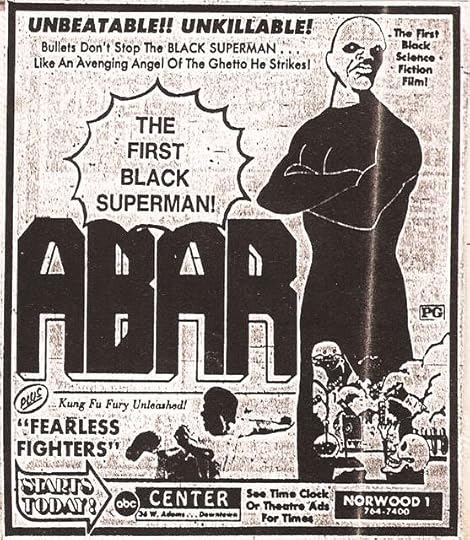
Listen, I’ve seen a lot of strange, obscure movies. More than you, I’m guessing. A lot more. But this forgotten 1977 blacksploitation non-classic, wow. It’s something else. Filmed on virtually no budget, and starring no one you’ve ever heard of, it manages to be sleazy and heartfelt, laughably ridiculous and achingly serious all at the same time. The story starts when a renowned African-American doctor and his family move into a white Los Angeles neighborhood. Their racist neighbor is so dumbfounded by this news that she ignores reality and assumes the doctor and his wife are the chauffeur and maid of the white family who really bought the house. Matters get even uglier as racist protesters march in front of the house (a certain “n” word is heard many, many more times than it would be in a 2015 movie) and thugs attack the doctor and his family. Eventually, Abar, the leader of a motorcycle-riding black power group makes it his mission to protect the family, and even more eventually (this movie is slooooooooow), the doctor reveals his real mission: to develop superpowers in his basement lab and give them to a worthy hero. Once Abar inevitably gets those powers, the movie really gets strange. Abar becomes more like a wizard (or a god) than a superman, causing reality to change with the blink of an eye: He turns wine bottles into milk bottles, dropouts to college grads (complete with caps and gowns!) and a preacher’s new car into a horse and buggy. It makes no sense, and it’s tonally a million miles from what came before, but is it entertaining? You bet it is! And, believe it or not, “Abar” saves its craziest moment for the end, which I will now spoil for you (because, honestly, are you going to watch this movie?) Remember the white racist neighbor from the beginning? Turns out our heroic doctor discovered she actually has sickle cell anemia – meaning that she’s actually black, just like the family she hated. If that’s not a powerful statement about racial harmony, I don’t know what is. In fact, no matter what it is, I don't know what it is.
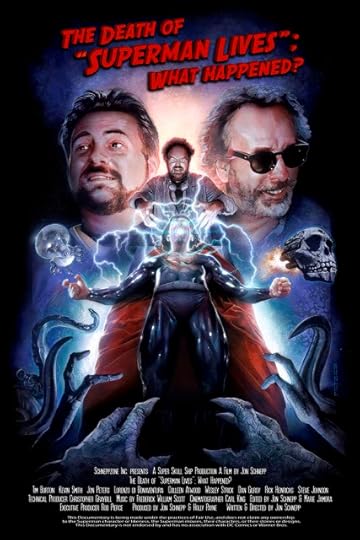
This examination of just why the much-talked-about Tim Burton/Nicolas Cage Superman movie never took flight (hardy har har) is entertaining, but probably not as quite as entertaining as it thinks it is. Writer/ Director Jon Schnepp talks with almost all the main players (except for Cage, who is glimpsed in footage of costume tests), and most of them have interesting tales to tell about what the movie might have been, but the problem is, this movie sounds TERRIBLE. I mean the concept of Superman using some sort of robotic Kryptonian babysitter to reincarnate after his mid-movie death could possibly be mildly interesting, I guess, but the look, tone and style of what Burton and Co. are proposing make the whole thing seem unwatchable. Still, it’s worth watching “The Death of Superman Lives” just to see that producer Jon Peters is just as insane as Kevin Smith keeps telling everyone he is.
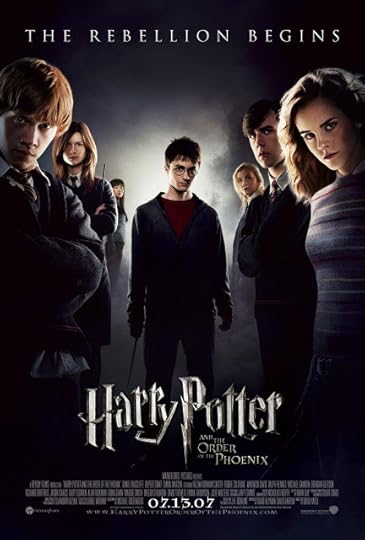
As I wrote in the last post, Allie’s obsession with Harry Potter continues, and thus so does our scattershot film festival. I like these movies, but I have to admit that, as an old man whose brainpower is focused on old “Star Wars” trivia and “Kojak” supporting actors, I can’t really remember who’s in which movie and what the hell they’re up to. They’re still a lot of fun, though, and this series might have the single strongest continuing cast I’ve seen in a long time. Joining the action this time around is Imelda Staunton as Dolores Umbridge, a woman who, despite the fact that she doesn’t use much magic, manages to be a nastier villain than ol’ Voldemort himself, mostly because she’s the sort of awful, frustrating, powerful person you’d actually encounter in the real world. She’s defeated a little too easily at the end of the movie, but I have to admit, it sure is satisfying when she gets hers.
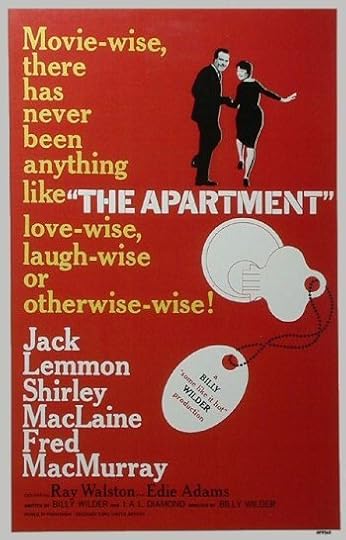
I re-watched this Billy Wilder classic for an episode of Out of Theaters ( listen here ), and if I wasn’t sure before, this umpteenth viewing confirmed it: “The Apartment” is one of my absolute favorite movies, maybe (depending on when you ask me) my single favorite movie of all time. There’s nothing about it I don’t love: The early ‘60s Manhattan setting, which was a colossal influence on “Mad Men.” The gorgeous cinematography and art direction (by Joseph LaShelle and Alexander Trauner, respectively). The three leads – Jack Lemmon, Shirley MacLaine and Fred MacMurray – all of whom deliver career-best performances (well, MacMurray may be better in Wilder’s “Double Indemnity,” but it’s a close call.) The supporting cast, which is dead-solid perfect down to the smallest role. The score (by Adolph Deutsch) which knows when to calm down and knows when to swell gloriously (like, for instance, during Fran’s run back to the titular apartment). And, most of all, the script by Wilder and I.A.L. Diamond, which ranks among the finest ever written, combining sharp comedy with serious drama and genuine sentiment. What’s more, it’s a structural marvel, setting up its plot perfectly and dropping characters in just when it makes sense. Wilder and Diamond also pack it with little side-gags and touches that manage to make “The Apartment” a richer experience without ever being distracting. The next time you watch this movie (and might I suggest giving it another look – or, God forbid, your first look – during this holiday season), keep an eye on the following elements: Fran’s makeup mirror, Baxter’s apartment key, Baxter’s “young executive model” derby and one of the bottles of champagne that’s dropped off near the end of the movie. All of them help drive the plot, and all of them become something else (and something more important) as the film nears its climax. I didn’t notice that sort of thing the first time, but “The Apartment” is definitely one of those movies that rewards repeat viewings. Personally, I can’t wait to watch it again.
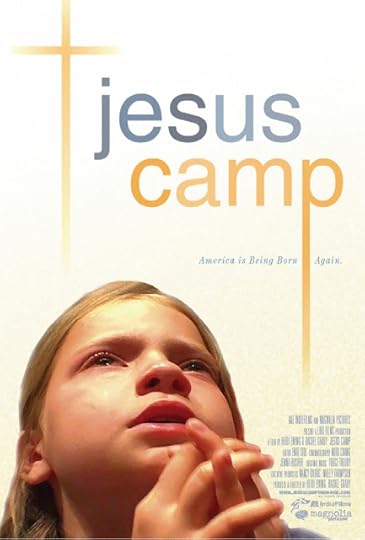
Alternately amusing and terrifying, this 2006 doc follows a group of children as they attend Kids on Fire, a camp run by Becky Fischer, an evangelical teacher who also manages to be both amusing and terrifying herself as she cheerfully describes how she and her staff keep their youthful charges from even sticking a single toe off the path of godliness. It's all appalling, of course, but the kids have been brainwashed since birth, so they're perfectly happy -- joyful, even -- to spend their summer being driven to tears by adults berating them for doing things any normal kid does. Even when they sit around in the bunks after lights out and try to amuse each other by telling an ancient camp ghost story, some soft-spoken killjoy steps in and tells them Jesus doesn't like ghost stories. Except his own, of course. Definitely worth watching, and it gets even more unnerving when you realize this kids in this movie are now old enough to .... vote. Now that's a scary story!

Listen, I’ve seen a lot of strange, obscure movies. More than you, I’m guessing. A lot more. But this forgotten 1977 blacksploitation non-classic, wow. It’s something else. Filmed on virtually no budget, and starring no one you’ve ever heard of, it manages to be sleazy and heartfelt, laughably ridiculous and achingly serious all at the same time. The story starts when a renowned African-American doctor and his family move into a white Los Angeles neighborhood. Their racist neighbor is so dumbfounded by this news that she ignores reality and assumes the doctor and his wife are the chauffeur and maid of the white family who really bought the house. Matters get even uglier as racist protesters march in front of the house (a certain “n” word is heard many, many more times than it would be in a 2015 movie) and thugs attack the doctor and his family. Eventually, Abar, the leader of a motorcycle-riding black power group makes it his mission to protect the family, and even more eventually (this movie is slooooooooow), the doctor reveals his real mission: to develop superpowers in his basement lab and give them to a worthy hero. Once Abar inevitably gets those powers, the movie really gets strange. Abar becomes more like a wizard (or a god) than a superman, causing reality to change with the blink of an eye: He turns wine bottles into milk bottles, dropouts to college grads (complete with caps and gowns!) and a preacher’s new car into a horse and buggy. It makes no sense, and it’s tonally a million miles from what came before, but is it entertaining? You bet it is! And, believe it or not, “Abar” saves its craziest moment for the end, which I will now spoil for you (because, honestly, are you going to watch this movie?) Remember the white racist neighbor from the beginning? Turns out our heroic doctor discovered she actually has sickle cell anemia – meaning that she’s actually black, just like the family she hated. If that’s not a powerful statement about racial harmony, I don’t know what is. In fact, no matter what it is, I don't know what it is.

This examination of just why the much-talked-about Tim Burton/Nicolas Cage Superman movie never took flight (hardy har har) is entertaining, but probably not as quite as entertaining as it thinks it is. Writer/ Director Jon Schnepp talks with almost all the main players (except for Cage, who is glimpsed in footage of costume tests), and most of them have interesting tales to tell about what the movie might have been, but the problem is, this movie sounds TERRIBLE. I mean the concept of Superman using some sort of robotic Kryptonian babysitter to reincarnate after his mid-movie death could possibly be mildly interesting, I guess, but the look, tone and style of what Burton and Co. are proposing make the whole thing seem unwatchable. Still, it’s worth watching “The Death of Superman Lives” just to see that producer Jon Peters is just as insane as Kevin Smith keeps telling everyone he is.

As I wrote in the last post, Allie’s obsession with Harry Potter continues, and thus so does our scattershot film festival. I like these movies, but I have to admit that, as an old man whose brainpower is focused on old “Star Wars” trivia and “Kojak” supporting actors, I can’t really remember who’s in which movie and what the hell they’re up to. They’re still a lot of fun, though, and this series might have the single strongest continuing cast I’ve seen in a long time. Joining the action this time around is Imelda Staunton as Dolores Umbridge, a woman who, despite the fact that she doesn’t use much magic, manages to be a nastier villain than ol’ Voldemort himself, mostly because she’s the sort of awful, frustrating, powerful person you’d actually encounter in the real world. She’s defeated a little too easily at the end of the movie, but I have to admit, it sure is satisfying when she gets hers.

I re-watched this Billy Wilder classic for an episode of Out of Theaters ( listen here ), and if I wasn’t sure before, this umpteenth viewing confirmed it: “The Apartment” is one of my absolute favorite movies, maybe (depending on when you ask me) my single favorite movie of all time. There’s nothing about it I don’t love: The early ‘60s Manhattan setting, which was a colossal influence on “Mad Men.” The gorgeous cinematography and art direction (by Joseph LaShelle and Alexander Trauner, respectively). The three leads – Jack Lemmon, Shirley MacLaine and Fred MacMurray – all of whom deliver career-best performances (well, MacMurray may be better in Wilder’s “Double Indemnity,” but it’s a close call.) The supporting cast, which is dead-solid perfect down to the smallest role. The score (by Adolph Deutsch) which knows when to calm down and knows when to swell gloriously (like, for instance, during Fran’s run back to the titular apartment). And, most of all, the script by Wilder and I.A.L. Diamond, which ranks among the finest ever written, combining sharp comedy with serious drama and genuine sentiment. What’s more, it’s a structural marvel, setting up its plot perfectly and dropping characters in just when it makes sense. Wilder and Diamond also pack it with little side-gags and touches that manage to make “The Apartment” a richer experience without ever being distracting. The next time you watch this movie (and might I suggest giving it another look – or, God forbid, your first look – during this holiday season), keep an eye on the following elements: Fran’s makeup mirror, Baxter’s apartment key, Baxter’s “young executive model” derby and one of the bottles of champagne that’s dropped off near the end of the movie. All of them help drive the plot, and all of them become something else (and something more important) as the film nears its climax. I didn’t notice that sort of thing the first time, but “The Apartment” is definitely one of those movies that rewards repeat viewings. Personally, I can’t wait to watch it again.

Alternately amusing and terrifying, this 2006 doc follows a group of children as they attend Kids on Fire, a camp run by Becky Fischer, an evangelical teacher who also manages to be both amusing and terrifying herself as she cheerfully describes how she and her staff keep their youthful charges from even sticking a single toe off the path of godliness. It's all appalling, of course, but the kids have been brainwashed since birth, so they're perfectly happy -- joyful, even -- to spend their summer being driven to tears by adults berating them for doing things any normal kid does. Even when they sit around in the bunks after lights out and try to amuse each other by telling an ancient camp ghost story, some soft-spoken killjoy steps in and tells them Jesus doesn't like ghost stories. Except his own, of course. Definitely worth watching, and it gets even more unnerving when you realize this kids in this movie are now old enough to .... vote. Now that's a scary story!
Published on December 27, 2015 13:29
Will Pfeifer's Blog
- Will Pfeifer's profile
- 23 followers
Will Pfeifer isn't a Goodreads Author
(yet),
but they
do have a blog,
so here are some recent posts imported from
their feed.



